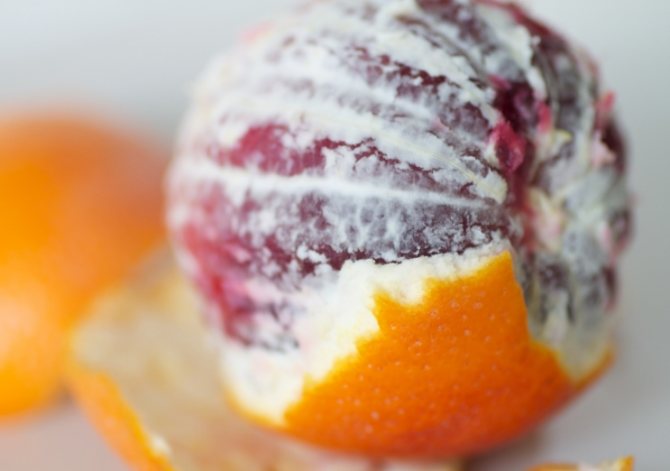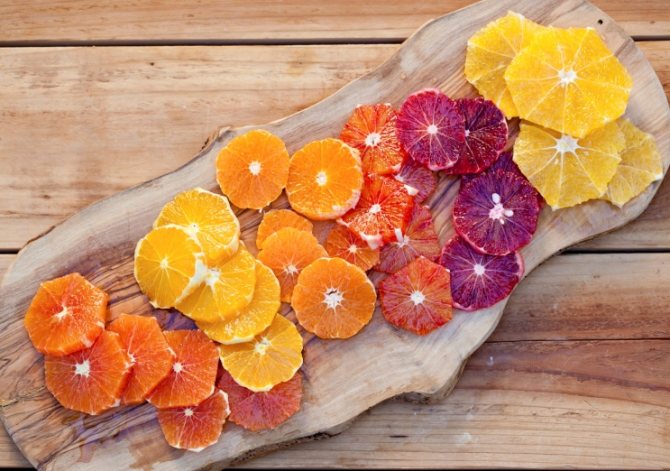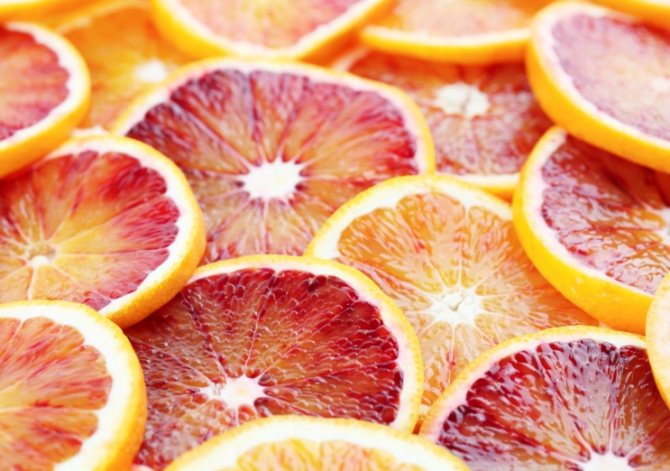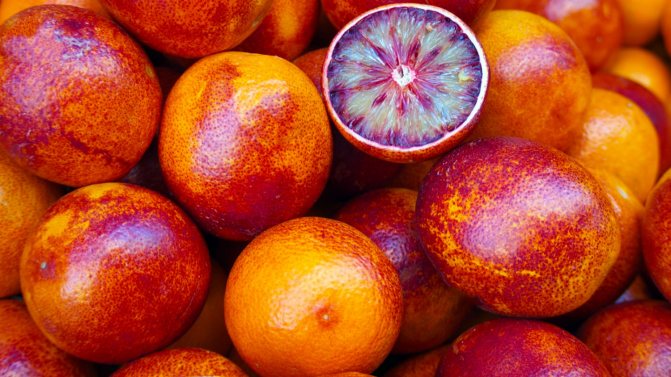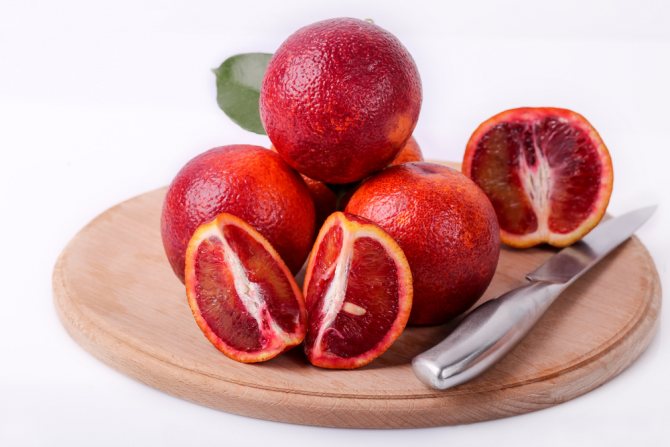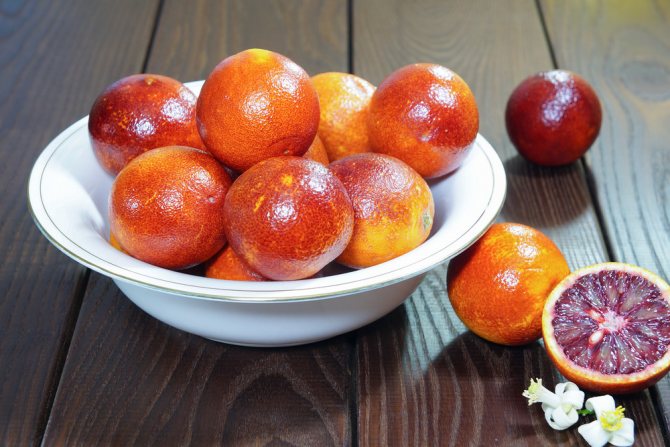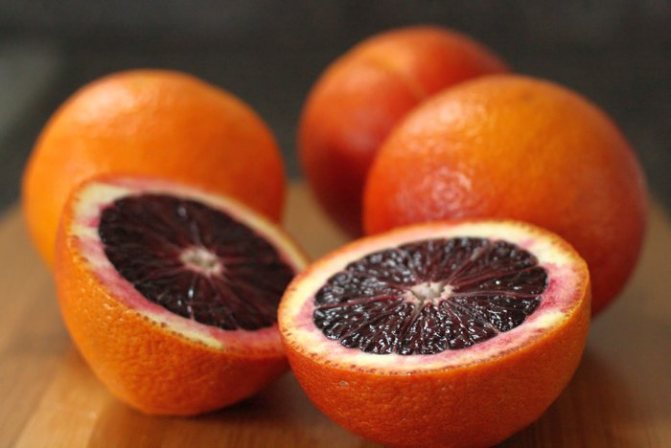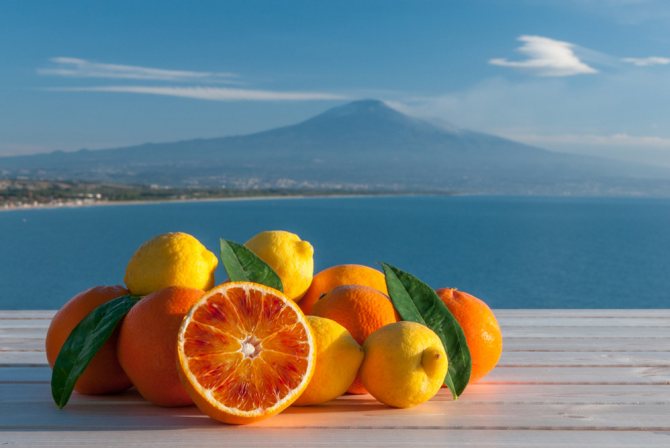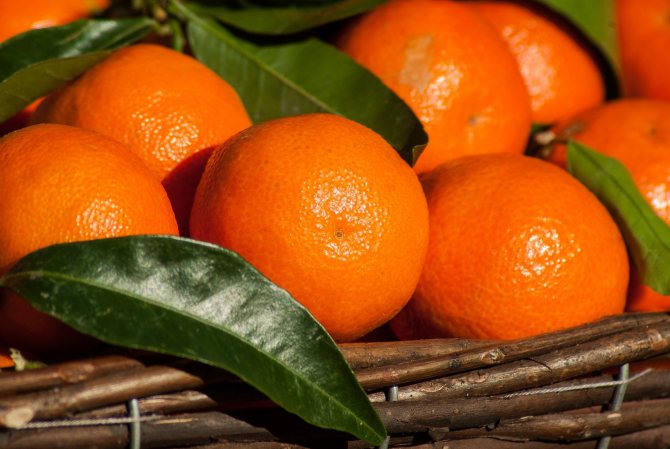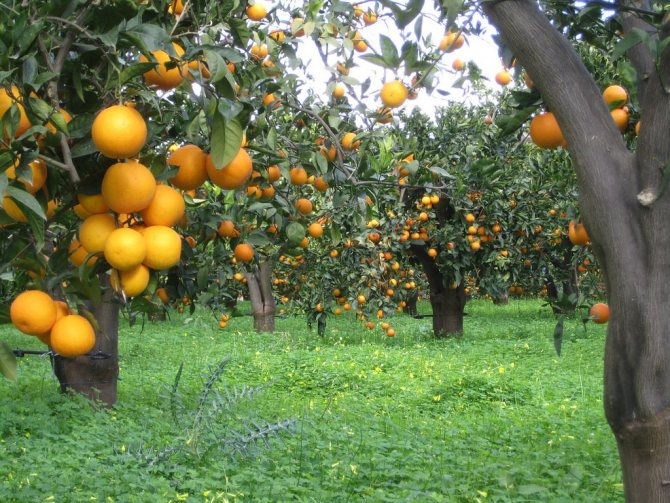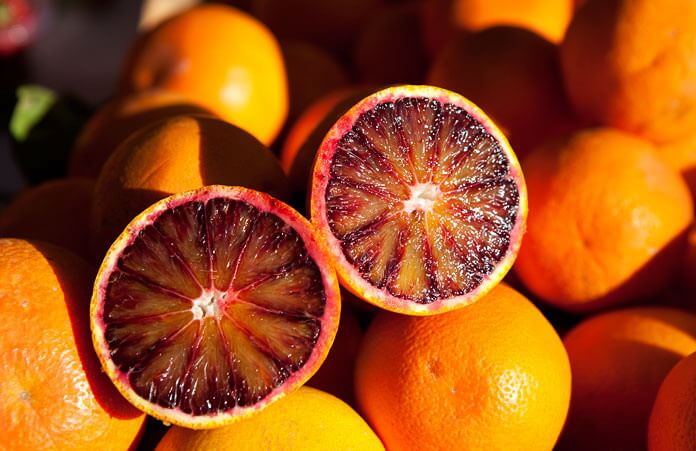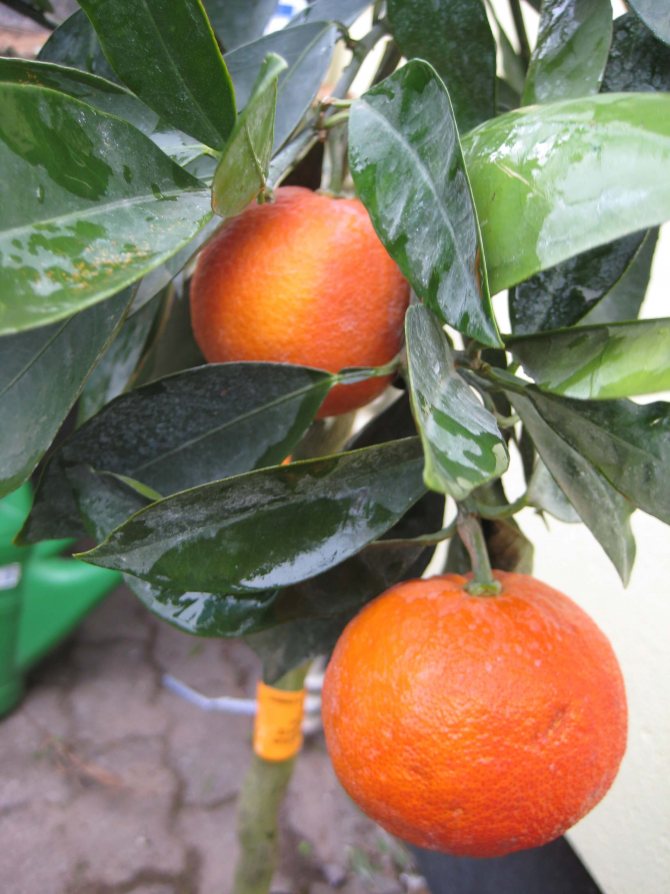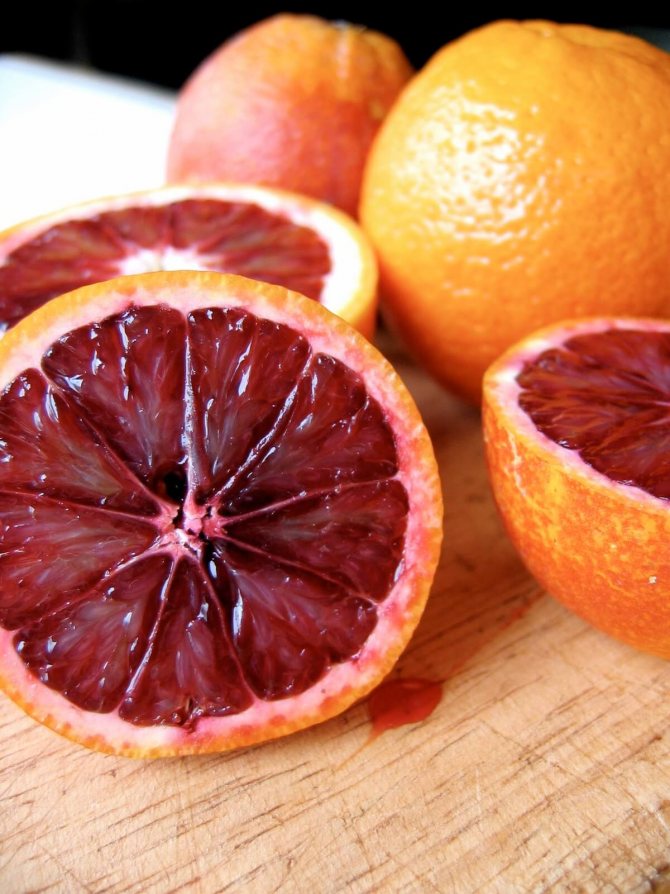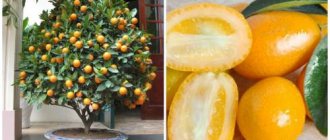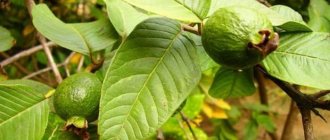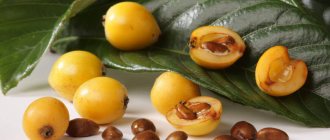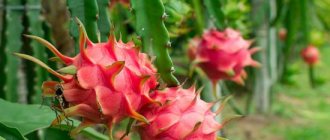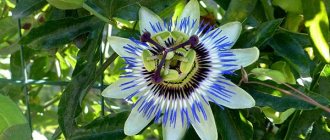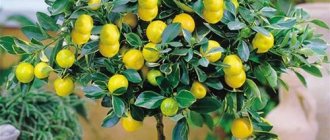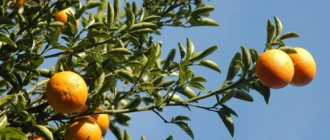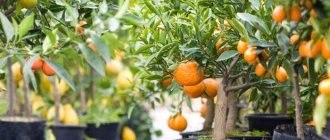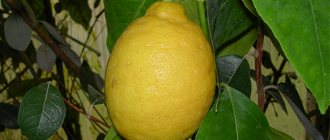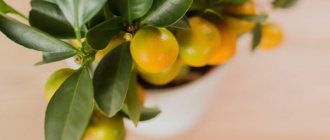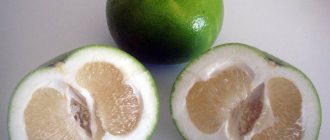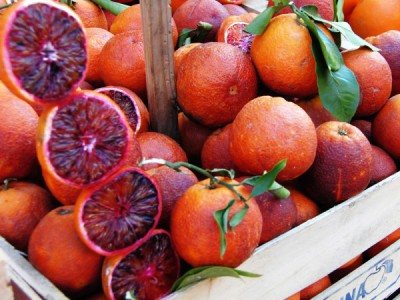
Sicilian red orange refers to the rut family together with other representatives of the Citrus species.
It is an evergreen tree with shiny oval leaves and white, fragrant flowers.
In nature, such a tree grows up to 6 meters tall and can bloom several times a year, so trees can often be seen bearing both flowers and fruits from the previous harvest.
Orange trees look very attractive, and many growers have thought at least once about growing a miniature version at home.
Origin and scientific name
The group of hybrids to which the Sicilian orange belongs is called Citrus × sinensis, which means "Chinese citrus" in Latin. This hybrid of mandarin and pomelo, originally from China, has been cultivated in the Mediterranean since the 18th century.
It was on Italian soil that the fruit acquired its "bloody" color, due to the characteristic temperature difference between the cold and warm seasons. Red oranges are also grown in some American states and South America.
There are several commercial varieties of Sicilian oranges: Moro, Sanguinello, Washington Nave and others, many of which are accidentally discovered successful mutations of previously bred varieties.
For beauty
Red orange is used in cosmetology, its constituent substances are used in creams, masks, scrubs, shampoos and many more skin and hair care products. An essential oil rich in antioxidants is produced from citrus peel, which is actively involved in the processes that prevent skin aging.
Orange oil is used for aromatherapy sessions, for massage and a variety of hardware cosmetic procedures.
Photos
Sicilian red orange: photo of a plant with bloody fruits.
Characteristic
Red orange has several other names: the king or bloody orange. The mutation from the common orange citrus first occurred on the island of Sicily in the 15th century. And since then it has been cultivated throughout Europe, the first fruit to appear in India.
The hybrid group, which includes citrus, is called Citrus × sinensis (translated as "Chinese citrus"). Oranges with red zest are made by crossing a pomelo and a tangerine.
Red orange has many varieties, most of them grow only in the Mediterranean strip. The name of the fruit (red oranges) comes from the color of their pulp, which is darker or lighter in different varieties due to the difference in seasonal temperatures in the homeland of the miracle fruit.
Description of the tree
Under natural conditions, the height of the red orange tree reaches 5.5-12 m. It blooms several times a season. This is one of the few plants that has both flowers and fruits from the previous harvest at the same time.
Blood orange trees belong to the rutic citrus family. Fruiting lasts for many years. The plant is tenacious.
Blood orange trees have the following traits:
- high;
- long-lived;
- constantly bearing fruit;
- unpretentious to soils;
- drought-resistant;
- with dense foliage;
- with a compact crown.
Round, gathered together, the compact crown looks attractive. The branches have thin thorns located directly towards the trunk.
The leaves are dark green, deep in color. They have an oval, slightly elongated shape.Leaf length - 6-7 cm, width - 3-4 cm.
The root system is large and can penetrate deeply into the soil. This quality allows blood oranges to survive dry periods.
Breeders have bred the dwarf trees of this fruit, and many growers purchase them to decorate their home interiors.
Description of fruits
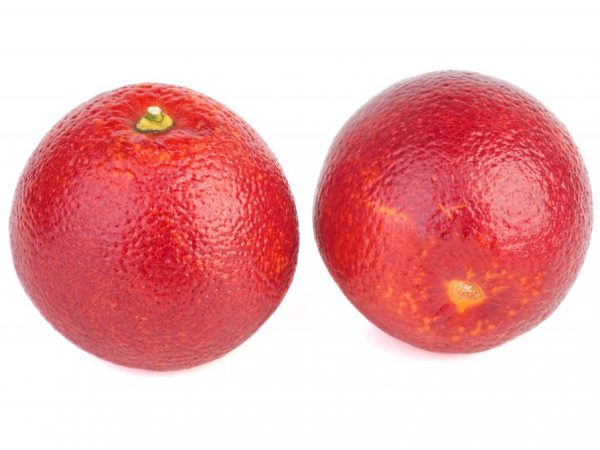

The variety will surprise you with the color of the fruit
The tree blooms with large white flowers with a characteristic aroma. On a branch, flowers are collected in groups (5-6 pieces in one inflorescence). Some varieties are characterized by the presence of axillary shields for external protection.
The flowers produce fragrant fruits with the following characteristics:
- rounded ribbed shape;
- easily detachable peel;
- weight 100-300 g;
- few bones (seeds);
- brightly colored pulp.
The taste of orange fruit with red pulp is sweet, with a subtle sourness. After consumption, a pleasant raspberry aftertaste remains.
Anthocyanin gives the fruit a unique color. Different varieties have slightly different flesh and rind color. In the pulp, it ranges from bright red to red-burgundy, and in the rind, from orange-brown to dark brown.
Fruiting occurs from December to June. One adult tree grows up to 500-550 fruits.
Home care
Immediately after purchasing a tree, you should evaluate the capacity and soil in which it is contained. If it is a thin plastic pot and / or pure peat, then transplant the orange into more suitable conditions.
Temperature and lighting
Orange is very temperature sensitive. Despite its southern origin, he does not like prolonged heat and can get burns from direct sunlight. The optimum temperature for flowering and fruit set is about 18 ° C. Frosts are also harmful, it is better not to leave the plant on the balcony when the temperature falls below 4 ° C.
However, a room with central heating is also not the best choice for wintering a Sicilian orange; it is better to move it to a cool place no warmer than 12 ° C. This will allow the plant to rest and bear fruit again next year.
Like all citrus fruits, a bloody orange loves bright places. Small plants do well on the windowsill; larger plants need a bright balcony or winter garden. Additional lighting may be required during winter.
In the spring, when there is no threat of frost, you can take the trees out to the balcony or garden. Natural irrigation with rainwater not only washes away house dust, but also gives an impetus to the beginning of spring growth.
For the first 2-3 weeks, put them in partial shade, and then take them out to a sunny place until the end of summer. It is necessary to clean for the winter in the reverse order, otherwise leaves may fall from a sharp change in lighting.
Diseases and pests
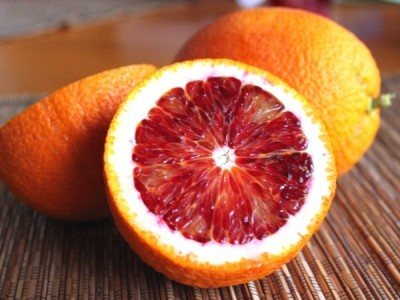

The most common orange tree problem is tendency to shed leaves, flowers and ovaries in any sudden change in the environment.
It can be caused, in particular, by lack of light, sun or chemical burns, excessive or insufficient application of fertilizers, dry air, problems with watering.
Orange tree weakened due to planting too deep and stagnant water may get gommosis... The characteristic feature of this disease is dark red spots and cracks in the bark, from which gum flows. The diseased plant must be transplanted, and the affected areas must be cleaned and sprinkled with an antiseptic.
In conditions of constant dryness, the tree can settle pests: aphids, spider mites, scale insects. Modern insecticides help well against insects if they are used according to the instructions.
The evergreen Sicilian red orange tree will adorn any apartment or winter garden, especially if you manage to achieve flowering.
Benefit and harm
One blood orange contains a daily dose of vitamin C, which has antioxidant properties, as well as potassium or magnesium, which are necessary for the health of the heart and blood vessels.
When consumed in moderation, red oranges help the body resist colds, mood, and stress resistance.
Allergy sufferers should treat these fruits with caution, as well as anyone who suffers from gastritis, ulcers or intestinal diseases.
The strong smell of flowers can exacerbate hay fever or asthma.
Local varieties of oranges with red flesh
On the territory of the countries of the former USSR, red oranges usually do not ripen, since they belong to the group of late ripening.
As an exception, the pear-shaped beetle, found in Georgia, is undersized, with small leaves and pear-shaped fruits weighing up to 120 g.
The peel is slightly rough, dense, medium separation. The color of the pulp is dark cherry, the taste is delicate, sweet and sour. The fruits contain a very small amount of single-embryonic seeds.
Photo gallery: orange red (click on the picture to enlarge):
Description of bloody or red orange
Red orange got its name from the peculiarity of the color of the pulp. The intensity of the color is given by anthocyanin - a special plant pigment that is found in fruits. Seeing this fruit for the first time, we ask ourselves: "Is this a hybrid of what?" Orange with pomegranate fruit? The rich color is very similar to pomegranate seeds. Orange with grapes? The color of the pulp resembles a wine grape hue. It turns out that this exotic Sicilian fruit appeared thanks to the crossing of two citrus fruits - pomelo with tangerine.
For the first time, red orange was cultivated in the warm climate of Sicily. Now, hybrids with bright pulp, unusual for our eyes, grow in the southern regions of Spain, China, Morocco, and the USA. There are varieties of bloody fruits - this is Tarocco, Sanguinello, as well as a new species - Moro.
- Tarocco is a medium-sized, round-shaped citrus with a red peel. The pulp is red-orange, pitted. The fruit has a wonderful sweet and sour berry aroma and taste. This is the most common variety.
- The Sanguinello variety is a citrus with an orange peel and an elongated, slightly elongated shape. It has a sweet, delicate red flesh. There are almost no bones. Often used for juicing, and of course eaten fresh. This is a late variety of sweet fruits.
- The Moro variety is an oval-shaped citrus with a bright orange peel, with purple-red pigment spots on it. The pulp is dark red, sometimes black and red, pitted. With a rich, well-defined raspberry flavor. This is an early fruit.
For bloody exotic climatic conditions play an important role. When changing the temperature regime and transplanting to another place, the color of the fruit may not be intense enough, up to the final loss of bright pigment.
These citrus fruits grow in areas with an arid climate, with a large difference between day and night temperatures in autumn and winter. This is exactly the characteristic climate of Sicily.
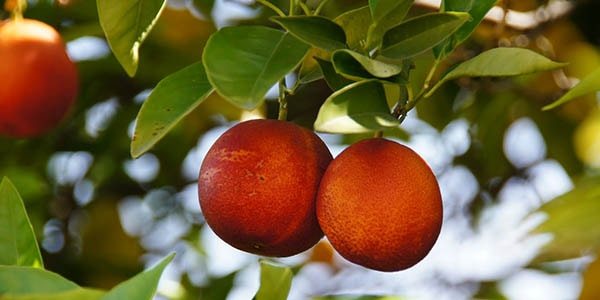

Plant lovers grow Sicilian fruits at home. The sight of the orange tree delights in the flowering and fruiting of small, tasty citrus fruits.
Fruit varieties
The red orange is a medium-sized tree with long, dense leaves. It blooms in small white flowers with a delicate aroma. One tree can produce up to 500 fruits weighing about 200-250 g. Fruits for more than six months, from December to June.
There are varieties:
Sanguinello is a rounded fruit with a rusty-orange peel and bright red flesh, it has a pleasant, sweet taste and is easy to peel. The variety belongs to the late and is used for making juices. The most delicious sanguinellos are grown in the provinces of Catania and Syracuse. It differs from other varieties in its delicate, delicate taste.
Tarocco is a small oval or round fruit that has an orange skin with red veins.The taste is sweet with sourness, the fruit is easily peeled from the skin. The pulp is pomegranate-red, contains a lot of vitamin C. Tarocco is the most popular variety.
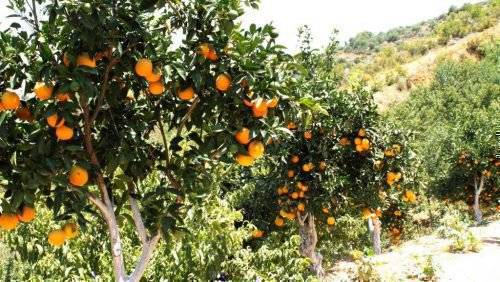

Moro - oval bright orange citruses with burgundy spots, dark pulp inside with a sweet and sour, slightly raspberry flavor. The fruit has almost no seeds; when overripe, the taste deteriorates. But the moro orange is the most useful in terms of the content of vitamins and acids.
On the territory of the post-Soviet space, red oranges cannot be grown, since they are late ripening fruits.
But there is an analogue - a pear-shaped kinglet growing in Georgia. A short tree with small leaves and orange pear-shaped fruits.
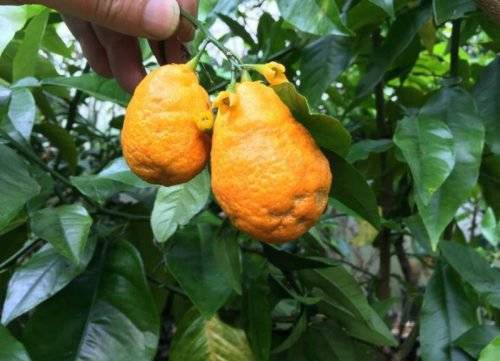

It has a rough, dense skin, dark red pulp with a sour-sweet taste. There are few seeds inside the fruit.
Composition and nutritional value
The fruit has an interesting, peculiar taste. It simultaneously resembles the taste of several berries: strawberries, grapes and raspberries. Some citrus varieties not only have a bloody pulp, but also a peel with the same color.
Red orange is a dietary product. It is recommended by dietitians. It helps with flatulence, dyspepsia, anemia and anorexia.
Bloody Sicilian oranges are low in calories. There are only 36 kilocalories per 100 grams of the product. The hybrid fruit is rich in fiber. When bloody citrus fruits are consumed, the body is quickly saturated, as the fiber swells and the stomach fills. And then the brain receives the command that the body is full. Therefore, the feeling of hunger goes away. Citrus improves the function of the large intestine. Bloody fruits are good thirst quenchers.
Nutritional value and composition of these exotic citrus fruits:
- carbohydrates - 8.1 g;
- proteins - 0.9 g;
- fats - 0.2 g.
Red sweet citruses are rich in micro and macro elements, rich in vitamins of different groups.
Fruit is used for cooking. All the sweet fruit, pulp, rind, even flowers from the tree are used.
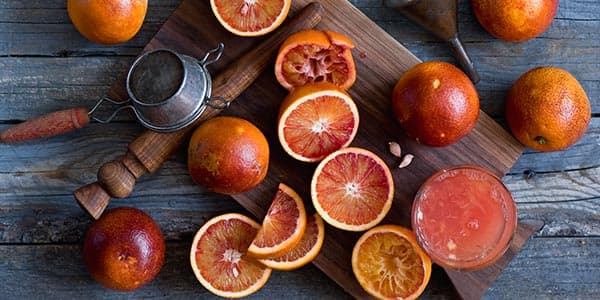

Oil is prepared from oranges, which is used in cosmetology - for creams, masks, scrubs, shampoos. In addition to beauty recipes, oil is used in culinary recipes to give the finished dish a new taste.
From the peel of the bloody fruit, an essential oil is produced, which is extremely useful. It is rich in antioxidants and helps prevent age-related skin changes. Beauty treatments, massage with orange essential oil, aromatherapy to raise the mood, bring the body to a calm or energetic state, depending on the procedure - this is not the whole list of areas of application of essential oil.
Passion fruit (grandilla), useful properties, composition, calorie content
The zest of bloody hybrids is tasty and healthy. Housewives use the zest as the basis for infusing liqueurs. For culinary purposes, the zest is used as a seasoning for meat or fish.
Culinary recipes
You can get the most of the benefits of red orange by consuming fresh fruits. Culinary experts and chefs often prepare second courses and salads from them, the aroma and taste of which is very difficult to resist.
One of these is fruit ratatouille, for which you need to take several ingredients:
- 2 red oranges;
- 2 green apples;
- 2 red apples;
- 2 ripe pears;
- 2 tbsp. tablespoons of granulated sugar;
- 100 g butter;
- 0.5 tsp. lodges. instant coffee and cinnamon;
- 200 ml fresh cream.
Peel the fruit, remove the seeds and cut into circles. Add cream to melted butter and half each cinnamon and sugar. Put fruits in layers in the resulting mixture, sprinkle with the remaining sugar and cinnamon. Sprinkle instant coffee on top for aroma. We bake in the oven at 180 degrees for 35 minutes. It turns out to be a very tasty dish!
You can make a simple salad with red oranges as the main ingredient.
You need to take a bunch of stalked celery, one orange, a handful of dried apricots and some raisins. Clean everything, cut as desired and pour over any fruit yogurt.
The zest of red orange is used to prepare liqueurs, and also as a seasoning for sea fish to remove its specific odor.
Description of bloody or red orange
Red orange is grown in the east of Sicily, around Etna, the largest active volcano in Europe, between the provinces of Catania, Enna and Syracuse. In other areas, breeding them is very difficult.
Similar citruses are grown in other parts of southern Italy, as well as in Spain, Morocco, Florida and California, but most connoisseurs agree that the original flavor of Sicilian oranges cannot be replicated in other climates.
Their characteristic reddish color is due precisely to the proximity of Mount Etna and the special microclimate in this area, primarily the large difference in temperature between day and night.
Like the bloody Sicilian orange, citrus crops also include limequat, grapefruit, pomelo, ponzirus, sweetie, lemon, tangerine, citron. Unlike other orange citrus fruits that contain only carotene (a yellow-orange pigment), red oranges also contain anthocyanins. These substances are responsible for the characteristic blood-red color of ripe fruits.
Did you know? Red orange (aurantium iudicum) was introduced to Sicily by a Genoese missionary returning from the Philippines and was first described by the Jesuit Ferrari in the Hesperides (1646). Until the 16th century, only orange oranges were cultivated there and only for decorative purposes.
Description of the red orange tree:
- An orange tree can grow up to 12 meters in height. Leaves are fleshy, evergreen, elongated.
- The flowers are white and very fragrant, diffusing an intense odor in the air, very delicate. In Sicily, they are a symbol of purity, and for this reason they are used to decorate wedding ceremonies.
- Growing an orange is only possible where the soil is very fertile and the climate is temperate.
- Each citrus tree can produce up to 500 fruits with more or less red coloration, depending on the variety.
- Ripening begins in December-January and continues until May-June in later varieties, so fresh blood oranges can be eaten for most of the year.
Blood orange varieties:
- Sanguinello: This variety was discovered in Spain in 1929 and later spread to other countries. The fruit has a spherical shape with sweet pulp and a rusty-orange peel with red spots. Ripening begins in February and harvesting takes place between March and April, when the fruits reach optimum ripeness. Ideal for juices.
- Moro: the most interesting of all, with pomegranate pulp and a very intense sweet and sour taste. Its dull, orange-rusty rind is covered with large, blurred, wine-colored spots. The fruit is oval or spherical, practically seedless, growing in clusters. Ripening begins in December, opening the orange season from the new crop, and continues from January to February.
- "Tarocco": first grown on the lands of Francofonte, located in the province of Syracuse. It is the most valuable bloody citrus. Fruits are obovate or spherical, orange peel interspersed with red spots, as they ripen, the spots expand and become more intense. Ripening begins in December and lasts until May. Tarocco is more popular than any other red citrus variety due to its wonderful taste and sweetness.
Does a red orange have any harm
Blood oranges, despite their sweet taste, contain a large amount of acids, for this very reason, it is better not to consume these fruits for persons suffering from high acidity. With an ulcer or gastritis, they are also a contraindication.These citrus fruits are also prone to allergic reactions, therefore, in case of hypersensitivity or individual intolerance to these Sicilian exotics, it is better to refuse them.
Women are not advised to abuse red oranges during pregnancy and while breastfeeding. This can prevent the development of allergies in the child in the future.
The acid content may not work well on tooth enamel and destroy it. Many people advise drinking the juice through a straw, however, to prevent harm, after the orange or its juice, it is enough to make it a habit to rinse your mouth with plain water or just drink some water.
Even in a perfectly healthy person, excessive consumption of red oranges can lead to diarrhea or flatulence. But these conditions soon disappear after removing fruits from the diet.
Nutritional value and composition
Chemical composition (in 100 grams of fruit):
- water - 87.2 g;
- protein - 0.7 g;
- lipids (fats) - 0.2 g;
- available carbohydrates - 7.8 g;
- soluble sugars - 7.8 g;
- total fiber - 1.6 g;
- insoluble fiber - 1 g;
- soluble fiber - 0.6 g
Energy value (per 100 g):
- calorie content - 34 kcal (142 kJ);
- edible part - 80%.
Important! Since one medium citrus (100 g) contains only 34 kilocalories, juice from them is used all over the world in weight loss diets as a low-calorie, but high-vitamin product.
Due to its excellent characteristics, sweet taste and aroma, this fruit is widely used in food. Its use in cooking is diverse, both individually (juice, fruit slices) and in more complex dishes: appetizers, desserts, pies, sweet pastries, in first and second courses, in side dishes, salads.
Sicilian blood oranges are used to make excellent fresh juices.
In the food industry, these fruits are used for the production of juices, candied fruits, jellies, dried fruits and jams.
It is not difficult to make marmalade from fresh Sicilian red citrus fruits at home, for this they take the pulp, zest and rind of the fruit. Housewives also make sweet jam or preserves from this orange (with added sugar).
With all the benefits of red (bloody) oranges, in no case should you give up the usual fruits with orange pulp. They also have a ton of beneficial vitamins and minerals.
Where use
Red orange is quite actively used in cooking, and not only citrus fruits themselves are used, but also the juice obtained from them, and even its peels.
- Orange juice is cold pressed and released in three forms: as a frozen concentrate, as a ready-to-drink liquid (in this case, the concentrate is diluted before the upcoming sale) and as a non-concentrated juice. Freshly squeezed juice, which is very popular in the homeland of this plant, has nutritional value, gives strength, and when processing other fruits with it, prevents them from darkening.
- Whole oranges are popular all over the world, so they don't linger on the shelves. It is eaten as a dessert, used in fruit salads and in a wide variety of dishes.
- Orange peels are used to make zest, which is prized as a condiment. The aromatic seasoning is used for desserts, baked goods, gravy, meat dishes and more.
In addition to cooking, orange peels are used as a natural air freshener, dried, they are part of the fragrance for living quarters. The oil obtained from the peel of oranges has also found application, it effectively repels insects and is used in the production of furniture care products.
Now Reading: Unusual Fruit - Finger Citron
Useful properties of red orange
This fruit is effective in treating the following conditions:
- phlebeurysm;
- low hemoglobin levels;
- viral respiratory diseases;
- alcohol intoxication;
- heart diseases;
- bronchitis;
- hypertension;
- tuberculosis;
- asthma;
- rheumatism;
- pneumonia;
- obesity.
For obesity, it is also recommended to use acacia honey, sea buckthorn leaves, beets, parsley, kale, celery root.
Important! It is very useful to consume orange juice immediately after squeezing, within 15-20 minutes, if possible, because it retains all the organoleptic characteristics that are lost during long-term storage.
The main component of Sicilian red citrus is vitamin C, which:
- strengthens the immune system and is an excellent natural immunostimulant;
- reduces the risk of colds;
- prevents miscarriage in pregnant women;
- promotes the activity of the adrenal glands;
- helps prevent myocardial infarction and stomach cancer;
- helps to mitigate damage to internal organs from smoking;
- stimulates an increase in the level of hemoglobin in the blood, as vitamin C promotes the absorption of iron by the body.
To strengthen the immune system, you can use ziziphus, ginger, pumpkin, pomegranate, cherries, garlic.
It also contains vitamin A, vitamins B1, B2, B9, useful in preventing the occurrence of genetic defects during intrauterine development of the fetus.
It is rich in vitamin P, which increases the strength and elasticity of blood vessels, and vitamin E, which protects against cardiovascular disease (ischemia) and prevents varicose veins and cellulite.
Red orange contains beneficial minerals:
- calcium;
- selenium;
- bromine;
- zinc;
- iron;
- copper;
- phosphorus;
- magnesium;
- potassium.
They are all good for human health.
Did you know? In the 19th century, the cultivation of red citrus in Sicily took on a primary role in the island's economy and continues to this day.
Medicinal properties:
- Orange juice has a sedative and antidepressant effect. Its pulp contributes to the good functioning of the gastrointestinal tract; it also has antispasmodic properties.
- Red orange juice is rich in anthocyanins, which, in addition to giving the flesh and skin the typical red color, are excellent antioxidants, remove dead cells from the body, fight free radicals and have anti-aging properties due to the presence of collagen, which is necessary to create or repair damaged tissues.
- Anthocyanins also help fight obesity by lowering blood cholesterol and preventing the accumulation of unhealthy fat. In conjunction with the digestive element (peptide), they induce a feeling of fullness, helping those who wish to lose weight and lose weight.
- These fruits contain: lutein (protects against aggressive sunlight, ultraviolet radiation) and carotene (improves vision).
Contraindications to use
Most products have contraindications for use and oranges are no exception in this case. Oranges with red pulp inside are not recommended for use:
- children who are not yet 1 year old, because there is a risk of rash and diathesis;
- people who have a stomach ulcer or duodenal ulcer, as well as with gastritis and an increased level of acidity, because citrus contains a lot of acids;
- people with diabetes, because oranges have a high sugar content;
- in cases where there is an allergy to citrus fruits, then it is also not recommended to use them.
These fruits are useful for pregnant women, but in small amounts, as doctors warn about. It should be borne in mind that during the second trimester and lactation, you should completely exclude them from the diet.
Description and photo of red orange
Red orange is a small tree with a pyramidal crown and oval medium-sized, slightly ribbed fruits weighing up to 250 g with an easily peeled skin. The pulp is juicy, coarse-grained, with few seeds, has a delicate sweet taste.
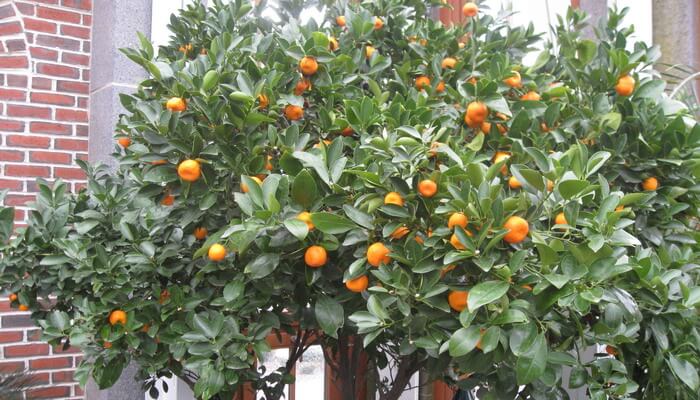

For the first time, oranges with red pulp appeared on the island of Sicily, and at first they were cultivated only there, which is why they began to be called Sicilian oranges. Currently, they are grown throughout Italy, as well as in Spain, Morocco, very popular in the United States, where they grow in the states of California and Florida.
Note that although anthocyanins, which give fruits such an original color, are often found in fruits and flowers, they are practically not found in other types of citrus fruits. It is not known exactly why red oranges appeared in Sicily.
There is a hypothesis that this was facilitated by the combination of the climatic conditions of the island and the unique composition of its soil, due to the proximity of Mount Etna. And now, despite the prevalence of korols in the world, the most delicious are those grown in the provinces of Catania, Syracuse and Enna, located directly near the famous volcano of Sicily.
Features of the crown
The size of the tree is average, sometimes even below average. The shape of the crown is round, wide, the branches tend to grow to the sides, which creates certain inconveniences for room maintenance. The plant is relatively frost-resistant, capable of withstanding a short-term cold snap down to minus 5 ° C.
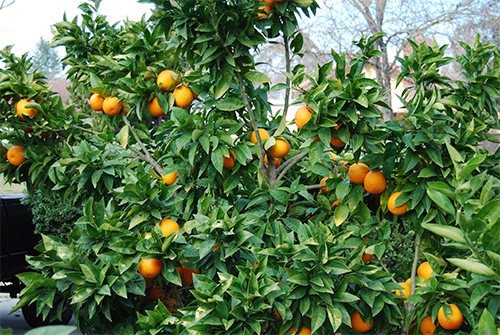

It is worth noting that the variety develops well only in conditions as close as possible to those that nature has created in Sicily. In indoor maintenance, it is complex: in the first years it grows slowly, especially on its own roots, the fruits rarely ripen to the degree of redness that distinguishes the plant from others. Strongly susceptible to attack by red spider mites.
What is the name of the red orange variety?
Currently in the world, Spanish kinglets are most often grown:
Tarocco, the most common of red oranges, with round fruits weighing 150-200g. The skin, bright orange with red veins, is thin, fine-grained, easily removable. The pulp is orange-red, has a sweet and sour taste with a berry tint. The juice is ruby-colored, moderately sour, and, like the fruit in general, is distinguished by an exceptionally high content of vitamin C.
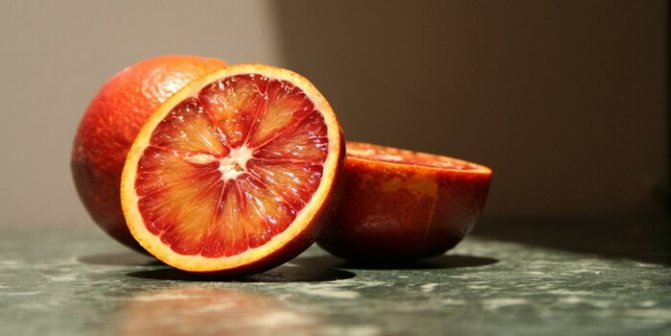

Sanguinelli, refers to the "double" king, because it has red pulp, juice and rind. Fruits are medium in size, elongated or round, less pigmented than other varieties. It has an intense orange peel with a red tinge of medium thickness and graininess, easily separating from the pulp. The pulp itself is bright red, practically without seeds, has a delicate, delicate taste, in comparison with other beetles there is less acid and anthocyanins. The color of the juice is red-orange. The variety is late ripening, ripens after the Tarocco and Moro red oranges have been harvested, and is valued as a transitional variety. It has long been grown on the plantations of the provinces of Catania and Syracuse in Sicily, it is believed that it is here that its fruits have the best taste.
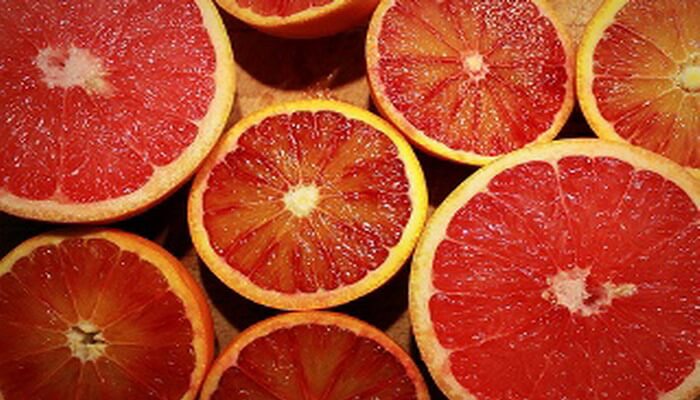

There is a variety, Muscat sanguinello, characterized by larger and elongated fruits, less intense color and taste with a pronounced nutmeg tint.
Moro (Moro), the earliest and most pigmented of the beetles cultivated in Italy and Spain. The fruit is oval, medium in size, with a bright orange peel, covered with red-violet pigmented spots by the time of full maturity. The thickness of the skin and the degree of grain are medium, sometimes there is a small navel. The color of the flesh is dark red, almost black, especially in the upper part of the fruit, where dark veins are clearly visible. Seeds are missing. The fruits are juicy, ripe with a pleasant taste, overripe fruits have a strong odor and unpleasant taste. The juice is dark red, contains the highest amount of anthocyanins and acid in comparison with other beetles.
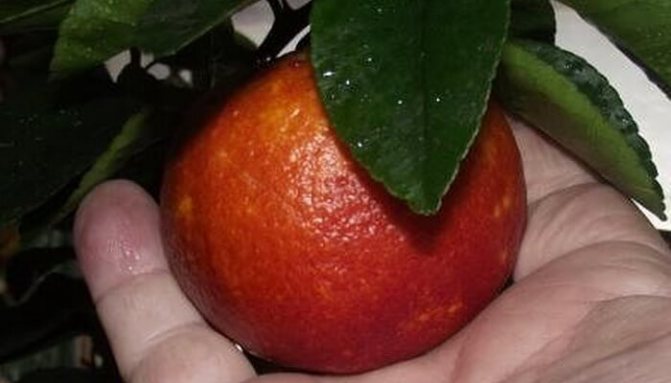

Oranges \ C. Sinensis
Orange "Chocolate" 1500 rub
Washington Navel CRC 3033 \ Navel Chocolate \ (Brown orange, orange verde)
A new and rare variety. Plant with good vigor, with small thorns.Fruits are of a standard size for oranges; when fully ripe, the peel acquires a dark brown, chocolate (bronze or copper) color. The taste is very complex and delicate, pleasantly sweet, very aromatic, with a high juice content. The main flowering wave is in March, the harvest is from December to February.
Orange "Washington-Nevel" 500 rub
C. sinensis "Washington navel"
Early maturing variety. Fruits are medium to large, from spherical to slightly elongated. The characteristic feature is the "navel" (an underdeveloped second fetus). The pulp is juicy, sweet, aromatic. The variety is very popular due to its high taste.
Orange "Shamuti" 500 rub
C. sinensis "Shamouti" \ Palestine Jaffа \ Jaffa orange \ Palestine orange
Jaffa orange (Jaffa / Jaffa), also known as "Shamouti" / "Shamouti orange" is a popular orange, almost seedless, with a tough peel (which is easy to peel), making it especially suitable for export. Orange "Shamuti" is Israel's "calling card". Due to its sweet taste and special aroma, it has become the best-selling in the domestic market and the most popular for export. The fruit has a great taste and aroma. Developed by Palestinian farmers in the mid-19th century, the variety takes its name from the city of Jaffa, Palestine. A mutation of the Beledi variety, which was grown in gardens around the city of Jaffa. The appearance of this variety of oranges (Jaffa / Shamouti) dates back to 1844. The main export citrus for Palestine. One of the three main varieties of oranges grown in the Middle East. These oranges are considered to be very cold hardy.
Orange "Fukumoto" 500 rub
C. sinensis navel "Fukumoto"
This cultivar originated in Japan as a kidney mutation of the Washington Navel cultivar. Early maturing, ripens three to four weeks earlier than maternal, already in October. The plant is medium-sized with a spherical crown. The leaves have a short petiole, often lacking lionfish. The flowers are large, creamy white, blooms very profusely. The fruit is large, intense reddish-orange in color. Its fruits are rather large (7.5-8.5 cm), spherical or slightly flattened, weighing 300 grams and have a small navel. Yellow-orange or orange peel, rather thick but soft. The pulp is aromatic, contains a lot of sugar and is very juicy with a low acid content. It is usually divided into 12 segments and contains only a few seeds. Japanese farmers harvest the fruit in February because the fruit has a higher taste when it hangs on the tree after ripening.
Variegated orange 500 rub
C. sinensis "Foliis variegatis"
A rare variegated orange variety. Leaves are white-green and white-yellow, attractive appearance. Fruits are medium to large, elongated to spherical. There are few seeds, sometimes not at all. Fruits at the beginning of ripening have a striped color, by the end of ripening they acquire a characteristic variety, yellow-orange peel, the stripes are colored orange. The pulp is very juicy, aromatic, tender, sweet and sour. The rind is of medium thickness.
Orange variegated (yellow variegation) 500 rub
C. sinensis "Foliis variegatis" (yellow leaf)
A rare variegated orange variety with yellow foliage variegation. Leaves are white-yellow, green-light green - an attractive appearance. Fruits are medium to large, elongated to spherical.
Orange "Fragola" 500 rub
C. sinensis "Fragola"
Orange "Fragola" (Strawberry) - the taste is sweet, juicy and aromatic. Fruits are large and medium in size. The pulp is slightly pigmented, very delicate, similar in structure to a homogeneous strawberry pulp. One of my favorite varieties.
Bloody orange "Sanguinello" 500 rub
C. sinensis "Sanguinello" \ Sanguinello blood orange
A popular commercial grade of "bloody" oranges. Fruits are medium in size with few or no seeds. The pulp is dark red, juicy, aromatic. The peel is of medium thickness, orange at the beginning of ripening, red at the end of ripening. High-yielding variety. Related varieties: Sanguinello Moscato, Sanguinello Moscato di Cuscuna, Sanguinello a Pignu
Orange "Sanguinello moscato"
C. sinensis "Sanguinello moscato nucellare"
Refers to the same group of pigmented / "bloody" oranges. Fruits are medium-sized, 150-200g, globular. The pulp is juicy, slightly pigmented. Ripening is medium-late - February-March.
Orange "Sanguinello moscato Cuscun"
C.sinensis "Sanguinello moscato Cuscun nucellare" 58-52F-1
Bloody orange "Sanguinelli" 500 rub
C. sinensis "Sanguinelli" \ Sanguinelli blood orange
A popular variety of "bloody" oranges. The rind and flesh are more intense purplish red (pigmentation) than other mild oranges.
Orange "Smith Red blood orange" 1200 rub
Smith Red blood orange \ "Smith Red Valencia"
American blood orange. Late variety, sweeter "Moro", more pigmented, variable shape, from spherical to ovoid. The taste and aroma of the pulp is berry. The yield is high. https://citrusvariety.ucr.edu/citrus/smithred.html
Orange "Moro" essential (bloody) 600 rub
C. sinensis "Moro nucellare" 58-8D-1 \ arancio dolce moro nucellare
Moro orange is the most colorful "bloody" orange, with dark red pigmented pulp and rind that has a bright red blush. The aroma is strong and more intense than that of a regular orange. This fruit has a pronounced, sweet aroma with a touch of raspberry. The color of the Moro flesh ranges from orange with ruby veins to bright crimson to almost black. The taste is sweet, berry, soft, delicate, without acid.
Orange "Kara Kara" 700 rub
C.sinensis "Сara Cara Navel"
Mutation of the "Washington-Navel" variety. Most of the traits reflect their origin, apart from the color of the pulp. The color of the pulp is the same as in the Star Ruby grapefruit, but more pink. The pulp is tender, aromatic. Sometimes trees produce variegated shoots, with striped (variegated) fruits.
Orange "Tarocco" variegated 600 rub
C. sinensis "Tarocco" foliis variegatis tardivo
Variegated orange "Tarokko" with pigmented pulp, late ripening. Fruits at the beginning of ripening have a striped color, by the end of ripening they acquire a characteristic variety, yellow-orange peel, the stripes are colored orange. The pulp is very juicy, aromatic, tender, sweet.
Orange "Tarocco", specialty 500 rub
C. sinensis "Tarocco nucellare" 57-1E-1
Orange "Tarocco" TDV for special purpose 500 rub
C. sinensis "Tarocco TDV nucellare"
The peel is smooth, orange. The pulp is sweet, tender, juicy. The aroma is berry, pleasant.
Orange "Tarocco Rosso" 500 rub
C. sinensis "Tarocco Rosso"
Fruits 160-210 grams, reddish-orange peel. The pulp is pigmented, reddish. The color of the fruit is consistent with the varietal characteristics and is more pronounced when night temperatures are low and there is a strong contrast between day and night temperatures. The juice is aromatic, pink and very low in acids. There are no seeds.
Orange "Tarocco Rosso" VCR 500 rub
C. sinensis "Tarocco Rosso"
Orange "Tarocco Halo"
C. sinensis "Tarocco Gallo nucellare" C 898
A variety of orange with pigmented pulp. Imported from China to Italy around the 17th century. Fruits are large, pulp with berry flavor and strawberry aroma. The variety is appreciated in Italy and abroad for its taste. The rind is thin, smooth, partially pigmented. Fruit without seeds, good transportability.
Orange "Tarocco deform" 500 rub
C. sinensis "Tarocco deforme"
One of the varieties of orange "Tarokko", leaves of different sizes and shapes.
Orange "Tarokko Tapi" 500 rub
C. sinensis "Tarocco Tapi"
It comes from Italy, formed by a natural mutation from the Tarocco cultivar. Brought him A. Starrentino in research, near Acireale near Syrakus. The tree is tall, spreading, with thorns, very productive. Fruits are of medium size, on average 7 cm, average weight 220 g, the base of the fruit is concave with a small neck. Orange peel with slight anthocyanin pigmentation, finely bumpy, soft, of medium thickness, tight-fitting. The pulp is rich orange with anthocyanin pigmentation, very juicy, of pleasant taste, with low acidity, has 10-11 segments without seeds.
Orange "Tarocco Chelif" 500 rub
C. sinensis "Tarocco Chelif"
A kind of "Tarokko" group, it tastes pleasantly sweet. Unknown origin. The variety was found in the citrus collection at the Villa in Menton (Palais Carnoles). Light orange when ripe. The pulp is almost seedless.
Orange "Tarokko Meli"
C. sinensis "Tarocco Meli nucellare" C8158
A variety of Italian origin. A tree with a broad crown, oval fruits, medium skin thickness and high sap content. The pulp is pigmented, with a berry flavor.Seeds are missing. Ripens later, from late March to early May.
Orange "Tarocco Messina"
C. sinensis "Tarocco Messina nucellare" C1635
Orange "Tarocco Ippolito" 600 rub
C. sinensis "Tarocco Ippolito"
Variety obtained in 1998. This variety begins to ripen at the end of January and harvest lasts throughout February and March. Fruit weight up to 200 g, oval shape, peel becomes dark red when ripe. The pulp is characterized by high pigmentation, with good juice yield and lack of seeds. It is one of the varieties whose fruits have the highest levels of anthocyanins, as well as a harmonious contrast between sugars and acids.
Orange "Tarocco S. Alfio" 500 rub
C. sinensis "Tarocco S. Alfio"
Orange "Tarokko Galichi" 11 500 rub
C. sinensis "Tarocco Galici" 11
Orange "Tarocco Tringale nucellare" 500 rub
C. sinensis "Tarocco Tringale nucellare" C3169
Orange "Tarocco Sciara nucellare" 500 rub
C. sinensis "Tarocco Sciara nucellare" C1882
Orange "Tarocco X Clementine" 500 rub
C. sinensis "Tarocco Sciara x C. clementino"
Orange "Vanilla Sanguinio" 500 rub
C. sinensis "Vaniglia Sanguigno" \ Acidless sweet orange
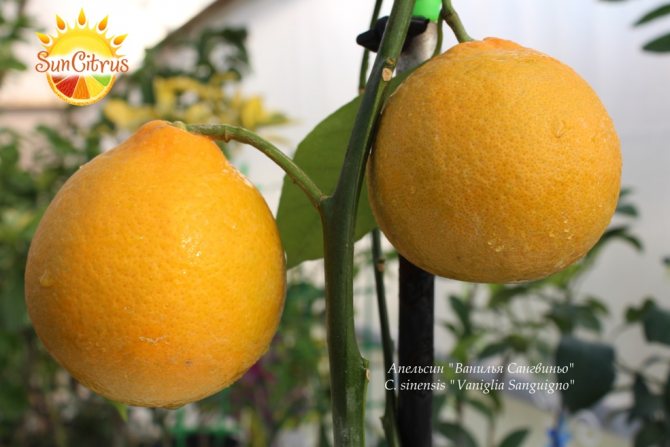

A sweet, juicy, acid-free orange. Fruits are medium in size. The peel is of medium thickness, yellow, yellow-orange, orange or reddish in color. The rind is hard, the navel is absent, the flesh is orange or reddish with a purple tint. The pigmentation is due to the pigment - lycopene. No night / day temperature difference is required for lycopene formation. Therefore, fruits can also have red flesh at home. The fruits are very juicy, well colored when ripe, sweet (do not contain acids - acid free). Ripening period end of autumn-beginning of winter.
Orange "Vanilla Apireno" 500 rub
C. sinensis "Vaniglia apireno" \ Acidless sweet orange
The vanilla orange is believed to have been introduced to Italy from India and possibly China around 1400. The "Vanilglia Apireno" orange is a non-umbilical orange derived from the seed mutation "Vanilla" that originated in the Ribera area and then spread throughout the area under the name Vaniglia Apireno di Ribera. It is one of the few orange varieties that falls into the low acidity category, as the acid content ranges from 0.06% to 0.15%. Although the sweetness is higher than that of any other orange (a predominance of vanilla flavor can be clearly seen from sensory analysis), it is low in sugar. Medium-sized fruits, very juicy, acid-free, medium-thick peel, easy to peel.
Orange "Valencia Leith" 500 rub
C. sinensis "Valencia Late"
Late, very productive and compact variety. Fruit ripening takes 12-15 months after flowering. One of the main late industrial varieties. Fruits are medium-sized 180-250g, dense orange peel, fragrant. The pulp is dark orange, juicy, sweet and sour. The taste is pleasant, balanced.
Orange "Valencia Campbell"
C. sinensis "Valencia Campbell" nucellare \ Campbell Old Line Valencia \ Fawcett Campbell
A late variety derived from the Valencia cultivar. The first tree of this variety was discovered on the Santa Anna farm in California in 1871. Described by P. Fawcett in 1942, it has since spread and grown throughout California. The fruits are practically indistinguishable from the parent variety, but the tree is somewhat larger, with a wide crown, and begins to bear fruit later. Fruits are medium in size (6-8 cm), spherical, slightly flattened, weight 160-250 g, orange peel, but with large green areas, bumpy, usually thinner, but can reach up to 8 mm in thickness, fragrant, easy to clean. The pulp is orange, good tasting, slightly less juicy, has 10 segments and few seeds. It tolerates warm dry air well, therefore it is suitable for growing in apartments.
Willow orange "Varya" 500 rub
C. sinensis "Varia"
An old variety of orange with willow leaves. Fruits are medium to large in size. The pulp is juicy, aromatic.
Orange "Skags Bonanza" 500 rub
C. sinensis "Skaggs Bonanza" \ Skagg's Bonanza navel orange
Umbilical orange - medium-sized fruit, orange peel, thin 0.3-0.5 mm. The pulp of a pleasant dessert sweet and sour taste, juicy, aromatic. There are no seeds. The variety is early, early ripening, high-yielding, thanks to these qualities, in my opinion, it can be recommended for indoor cultivation.
Orange "Four seasons" 500 rub
C. sinensis "Quattro stagioni"
This orange variety is often referred to as the four-season orange, because this variety has flowering throughout all seasons. On these plants, remontability is most manifested, fruits, flowers and buds are constantly present. The plant is very interesting from a decorative point of view.Ripe fruits on the plant can be found at any time of the year. The crown often grows vertically, the leaves are dark green in color. The most abundant flowering is in the spring, insignificant throughout the year. The flowers are white and very fragrant. The fruits are beautifully shaped, orange, very juicy and sweet. The taste is reminiscent of a group of navel oranges.
Orange "Sanguineum Pernambuco"
C. sinensis "Sanguineum Pernambuco"
Orange "Maltese Sanguinio" 500 rub
C. sinensis "Maltese Sanguigno"
Medium-sized tree. The fruit is slightly oval, almost seedless, of medium size. The rind is medium thick, soft and easy to peel. The pulp is juicy, sweet, with harmonious sourness. The intensity of the pigmentation of the fruit pulp and peel depends on the growing conditions: it can be more intense or less pronounced. Most often, the peel of the fruit is orange and has a slight red blush, and the flesh is orange with red blotches. The fruits ripen from January to February; if left hanging on the tree for a longer period, the palatability deteriorates.
Orange "Duretta del Gargano"
C. sinensis "Duretta del Gargano"
Orange "Newhall" \ "Nevelin"
C. sinensis "Newhall"
Newhall - also known as "Nevelin". Newhall Nucleus is a navel orange that is the result of a selection of a nucellar seedling descended from an old line of Newhall orange, which in turn comes from the Washington Newell orange shoot, in Duarte, California, and was selected by Paul Heckney. Newhall orange fruits ripen a little earlier and are slightly smaller in size with a deeper color of the skin, the color of the pulp is the same as that of the Washington Newell variety. Newhall is slightly less vigorous in growth, with darker leaves than Washington Nevel.
Orange "Navelite"
C. sinensis "Navelate"
Lane Leith Orange
C. sinensis "Lane Late NL C2611" nucellare
New South Wales, Australia, 1954 Late navel orange, the first of a series of Australian varieties that is either a sport or a kidney mutation of the Washington Newel. Habit and growth patterns are identical to Washington New. The fruit is the same size and shape, but has a smoother skin and a slightly smaller navel. The fruit ripens later than Washington New and can remain on the tree for several months without deterioration.
Orange "Oval Calabrian" 500 rub
C. sinensis "Ovale calabrese"
Orange "Shunko-Kan" 500 rub
C. sinensis "Shunko-Kan"
Orange "Oblungus" 500 rub
C. sinensis "Oblungus" \ Oblongo
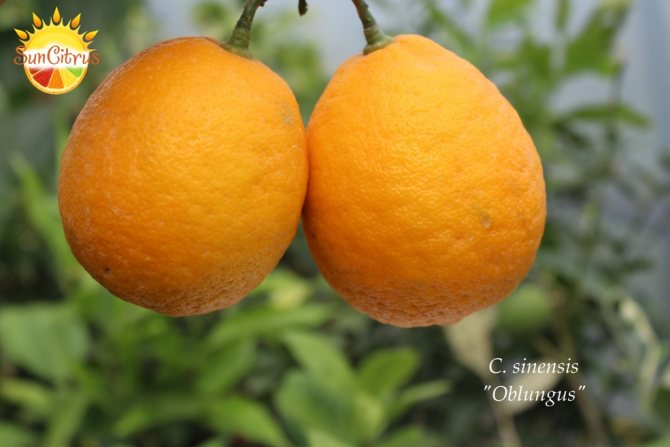

This orange is described in 1818. Presumably a hybrid between an orange and a lemon. Plants of medium growth rate, bushy, there are thorns. The variety is fruitful. The leaves are large, pale green. elliptical, with a jagged edge. The flowers are fragrant, white, collected mainly in groups. The fruit is lemon-sized in shape, oblong-ovate, slightly pear-shaped, with a "nipple" at the top. The peel is smooth, of medium thickness, yellow-orange when fully ripe. The pulp is very juicy, with a pleasant taste.
Hybrids
Tangor "Takle" 500 rub
Tangor "Tacle" - ibrido triploide (C. sinensis Tarocco x C. clementina)
Takle - a hybrid (triploid) - bred by crossing C. clementine "Monreal" X Orange "Tarocco" (C. sinensis "Tarocco"), in 1980. The growth rate is medium, the crown is compact. The shape of the fruit is flattened, the average weight is 150 grams. Today I tasted the first fruit. The peel is bright, orange-red, with a clementine smell, medium thickness. Mixed taste, between orange and clementine, more orange, juicy, aromatic. Unusual !!! I really liked the variety, there are no seeds.
Sicilian red orange: origins
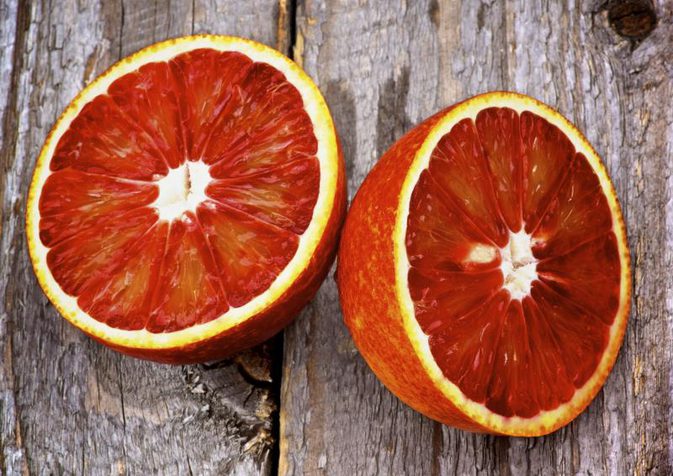

Most of us associate orange color with round, sweet, aromatic citruses, which nature itself has endowed with this intense color. And it's hard for us to imagine that not all oranges are orange. However, they are!
Moro, Tarocco and Sanguinello are a mysterious-sounding Sicilian "trio" with intense red flesh. These are exactly varieties, and not a hybrid, as one might think. Where do red oranges grow? They are grown in the provinces of Enna, Catania and Syracuse, in the southeastern part of Sicily.
Why is the orange inside red? The characteristic bloody color is a consequence of the proximity of Mount Etna and the specific microclimate in this area, especially the large temperature differences between day and night. Unlike other species, which have only carotene (a yellow-orange natural dye), red oranges also contain anthocyanins, which are responsible for the "trademark" blood-red hue of ripe fruits. It is believed that it is this unique combination of factors (in particular, the large range of temperatures day and night) that determines the uniqueness of Sicilian red oranges.
Similar fruits are grown in different parts of southern Italy, as well as in Spain, Morocco, Florida and California. However, most gourmets agree that the original taste of Sicilian oranges cannot be reproduced in other climatic conditions.
A bit of biography
It is believed that our hero is a fairly young species that arose at the very beginning of the 19th century. His ancestry stretches to the province of Lentini, in the vicinity of the Sicilian city of Syracuse.
Interesting! All red, navel oranges developed as industrial crops on this island, therefore they are also called "Sicilian".
Experts believe that this variety is a kidney mutation of the famous Italian orange "Sanguinello Muscato". However, there is another, less popular version, that he is a hybrid between pomelo and tangerine.
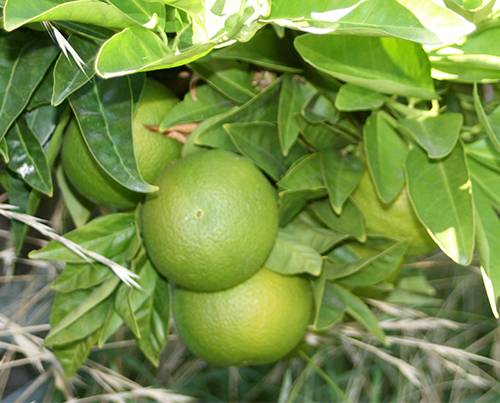

Curious! There were even rumors that Moreau arose by crossing an orange and a pomegranate (his flesh is so red, almost dark). However, this is completely impossible, because such plants are too remote in their biological nature.
Moreau belongs to the common industrial varieties. Its main advantage is the early ripening of the fruits, as well as their unusual taste properties.
Orange, red inside: variety names and uses
Just like the popular orange varieties, red oranges can be widely used in cooking. You can eat them just like that, in the form of juice or cocktail. They can become an excellent component of fruit salad or an original addition to delicious dishes. An attractive and unusual bloody color combined with a very sweet taste. This makes Sicilian oranges a well-known and very readily used additive by chefs.
The individual varieties of these red citrus fruits are slightly different from each other. Let's go over their characteristics a little.
Moro orange
The most colorful and "bloody", its taste and aroma are more intense than in the case of conventional varieties. This fruit has a characteristic sweetish taste with hints of raspberries. Contains a lot of anthocyanins
Tarocco orange
It is a medium-sized fruit, sweet, juicy and aromatic. The variety is especially popular in Italy. It has a thin orange skin that can be slightly reddish. The pulp is orange-red. Most often, seeds are not found in the fruits of this variety.
Sanguinello orange
Ripens during a short period between February and March. The rind is orange in color, delicate flesh and sweet taste, but less intense than Moro's. It is the most delicate, delicate of all varieties. It is very tasty to eat just like that and in the form of juice.
Varieties
Red orange has at least ten types, the most famous and common of them are the following varieties:
- Sanguinelli - the homeland of which Spain is considered, has a slightly elongated shape and rind with a slight blush;
- Moro - originally from sunny Italy, with a very dark, almost purple pulp;
- Tarocco (Tarocco) - with the shape of the fruit, resembling a ball and has the most fragrant and sweet pulp.
All varieties of red orange have a small amount of seeds, some of them do not contain any seeds at all.Vitamin C is much higher in them than in regular, orange oranges, which can usually be found on store shelves.
Now Reading: All the Nutrition and Health Benefits of Lime
Red oranges: properties and health benefits and harms
As for the benefits and harms, the Sicilian red oranges do not fundamentally differ from their orange "counterparts". Let's consider some of their characteristics.
- Like other citrus fruits, fruits are rich in vitamin C. Tarocco has the most of them compared to all red varieties. This is mainly due to the fertility of the soil surrounding Etna.
Vitamin C has many different functions in the body, from strengthening the immune system to improving the absorption of iron and increasing the elasticity of the skin and blood vessels. Together with other antioxidants (which are especially abundant in red oranges), it helps fight free radicals that affect, in particular, aging processes and skin condition.
- Beta-carotene, a precursor to vitamin A, indirectly affects vision.
- Hesperidin, found in significant quantities in bloody red oranges, has antioxidant and anti-inflammatory properties.
- The potassium present in citrus also has a beneficial effect on the heart.
- Anthocyanins, which distinguish Sicilian red oranges most from the popular orange varieties, have a positive effect, in particular, on the cardiovascular system. They have anti-inflammatory, anticoagulant effects, strengthen blood vessels. There is also information on the antitumor activity of anthocyanins.
Red oranges, like orange oranges, are best eaten with a thin, almost transparent skin immediately surrounding the flesh - the albedo. This will provide the body with additional fiber and flavonoids, which enhance the beneficial effects of vitamin C.
It is worth remembering that it is best to consume fresh, unprocessed fruits. In this form, they contain the most nutrients and fiber, which will be partially lost during exposure to high temperatures.
Eating red-fleshed oranges as juice provides more simple sugars but less fiber than eating thin-skinned fruit.
The harm to the health of Sicilian citrus fruits is "standard": the fruit will not benefit those who are allergic to it, people with ulcers and gastritis with high acidity.
For good health
The high content of vitamin C in red oranges makes them necessary to maintain the general condition of the body in an appropriate norm. Thanks to him, which is an antioxidant, the nervous system is strengthened, resistance to stress increases, the risk of heart pathologies decreases, and wound healing occurs faster. Vitamin C cannot be produced by the body; it must be constantly obtained from the outside, along with food.
Now reading: What is a kumquat and how it differs from other citrus fruits
Fiber content increases the amount of good cholesterol, normalizes blood sugar, and helps prevent colon tumors. The body will benefit from the content in red oranges of such essential substances as magnesium, calcium, potassium and B vitamins.
Orange or red oranges - which ones are healthier?
Sicilian and other varieties of oranges are undoubtedly worth consuming - in terms of both their nutritional and gustatory value. The Moro, Tarocco and Sanguinello varieties, due to their high anthocyanin content, may have an additional health benefit. And their original "appearance" and pronounced taste, as a rule, are more attractive to consumers.
However, this does not mean at all that it is worth abandoning the previously known varieties for the sake of the Sicilian "colleagues".Of course, it is worth knowing about their existence, about the beneficial properties of red oranges, but ordinary orange fruits must be present in the diet.
[collapse]
Description of fruits
This is the most unusual part of our plant. Much has been said about their unconventional color. Let's add that the color is highly dependent on the growing conditions. Ideally, during the ripening of the fruit, there will be a significant range of daily temperatures: cold nights and hot days.
Without this, the fruits lose their bright redness, become pale, almost of a standard color. Other external characteristics:
- The size is small (from 5 to 8 cm in diameter), the usual weight ranges between 120 and 180 grams.
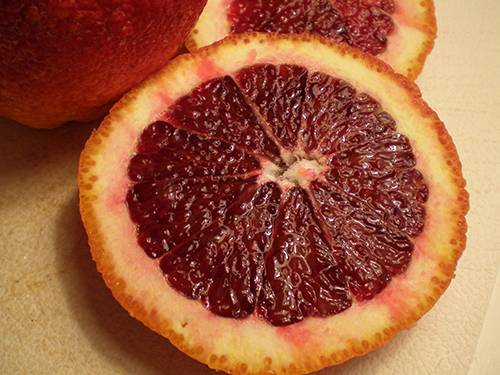

- Despite the fact that Moreau is in the group of umbilical oranges, his fruits are often devoid of a characteristic bulge, or it is almost invisible.
- They can hang on a tree for a long time without losing their properties, but when torn off they quickly deteriorate. This is one of the reasons why they are seldom sold outside of Italy.
- The shape is oval, the rind is dense, it is not easy to separate from the pulp. A slight tuberosity is visible on the surface, but sometimes it is absent.
- On the branches, fruits tend to be placed in small clusters, from 3 to 5 pieces, which gives the bush an additional decorative effect.


The pulp is especially interesting. It is very juicy, intensely red, almost black. Sometimes on its ruby background, darker veins are visible. The longer the fruit hangs on the tree, the darker the color of the pulp becomes.
Consumers note that the taste of these oranges is not that sweet, but very unusual and delicate. It is characterized by a complex palette, in which citrus fruits, raspberries, and even strawberries with currants are felt. This amazing aroma is the main advantage of this plant. Its fruits are used in the confectionery industry, used for the preparation of juices, mousses, and other drinks. We emphasize once again that the taste is highly dependent on the growing conditions.
There are few seeds inside the fruit, most often they are absent altogether. The pulp itself consists of 10 slices.
Thus, we have an early ripening, tasty, highly decorative variety of oranges, which has undoubted industrial value, but not easy to keep in the room. The more interesting it is to grow it!
Who is the red orange dangerous to?
As with any other product, there are also contraindications for the consumption of these fruits.
One of the types of sweet oranges native to Europe is called the Sicilian Red Orange. It differs from orange in its rich peel color and dark red pulp, and the taste has notes of strawberries, grapes and raspberries. The plant pigment, anthocyanin, is the reason for the characteristic color. Blood orange is the result of a mutation of a common one.
For the first time, oranges with rich red pulp were discovered on the island of Sicily in the 17th century. For a long time they were grown only there, therefore they were called "Sicilian". Now this type of citrus is cultivated not only in Italy, but also in Spain, Africa, China and the USA. The orange color was influenced by the proximity of Mount Etna and the microclimate of the island: a large difference in day and night temperatures and dry weather.
If you plant a tree in an unsuitable area for it, the fruits and pulp will not have their characteristic shade.
Proven usefulness
Not so long ago (in 2010), specialists again conducted studies, but already on obese mice. For some time, the animals were drunk with the juice of Sicilian oranges. The result was stunning, the mice began to actively lose weight. Scientists have proven that juice prevents weight gain and burns fat. It has also been found that regular consumption of this drink significantly reduces bad blood cholesterol.
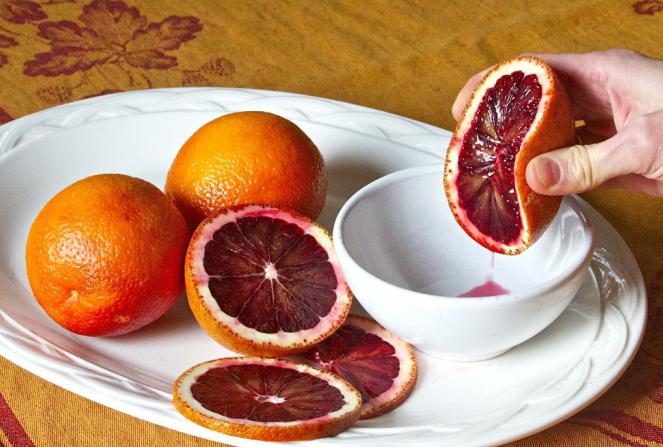

Structure
This citrus is rich in flavonoids, carotenoids, ascorbic acid, hydroxycinnamic acids and anthocyanins, folic acid.The ratio of these useful microelements, as well as taste and aroma, depends on the varietal variety of fruits.
The first thing we know about oranges is that they are rich in vitamin C. The blood orange is no exception, it holds the record among citrus fruits for the content of this useful vitamin.
Red oranges are rich in dietary fiber, that is, fiber, and are also high in antioxidants. In addition to the phytonutrients of these citrus fruits, vitamin C and fiber, they are a good source of folate, vitamin A (as carotenoids), vitamin B1, potassium, copper, pantothenic acid, and calcium.
Growing
The cultivation of red Sicilian oranges in Russia is practiced only at home. Climatic conditions do not allow growing a bloody orange outside. To grow it at home, the following nuances should be considered:
- The optimum temperature for flowering and fruit set is 18-19 degrees Celsius; for wintering or resting from fruiting, an orange needs a temperature within 12 degrees. Temperatures below 4 degrees are dangerous for the plant;
- Loves light very much;
- Indoor humidity should not exceed 50%;
- Sicilian oranges prefer soil in which moisture does not stagnate: a mixture of turf, sand and humus;
- Acidity indicators - 5.0-5.5 pH;
- You need to feed the orange with nitrogenous fertilizers;
- Neighboring plants can easily infect an orange with pests and diseases. For insects, insecticides are used.
Red oranges are unambiguously healthy to consume, they even lead the way over orange in terms of beneficial effects on health. Unusual appearance adds more appeal. The only thing is this "overseas" miracle is extremely rare in our country, and cultivation is possible only at home.
Photo gallery
Varieties of varieties
Sicilian citrus is a hybrid obtained by crossing a pomelo and a mandarin, not a pomegranate and an orange, as many think. Red orange is represented by different varieties, which differ from each other in some characteristics.
- Moro is a citrus variety with the most intense pulp color. It has a pronounced sweet raspberry flavor. It contains a lot of anthocyanins.
- Tarocco is a variety of red inside oranges characterized by medium-sized sweet juicy fruits. This citrus has a thin reddish zest. The color of the fruit pulp is orange-red. There are no seeds in Tarocco fruits.
- Sanguinello is a variety that ripens in February - March. The orange peel is orange and the flesh is tender and sweet. Because of this, Sanguinello is usually eaten fresh or made into juice.
Valuable properties
Red oranges are indispensable for strengthening weakened immunity, especially after previous illnesses. Any fruit can envy their biochemical composition. Citrus fruits are rich in vitamins B, C, A, P. It should be noted that they contain a lot of flavones. These valuable substances restore connective tissue, strengthen tooth enamel and bones. These components help to strengthen capillaries and blood vessels, and therefore can be used for varicose veins, hemorrhoids and cellulite.
Main characteristics of the orange plant
Orange is a flowering, woody, evergreen plant with a continuous growing cycle, that is, at the same time there can be ripe and green fruits on the tree, as well as flowering baskets. The fruit of orange trees is prized for its taste and aroma. In the Mediterranean, Asian countries and South America, hectares of orange plantations are cultivated. In southern Europe, alleys with citrus hybrids adorn central streets and squares.
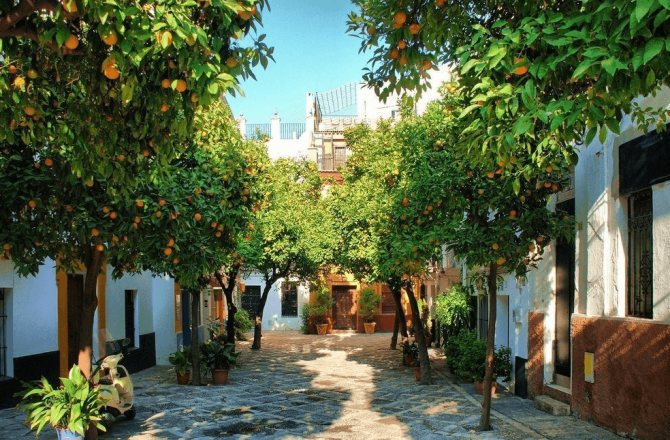

Orange trees adorn streets and courtyards in Spain
Orange is an unusual plant in a number of characteristics. It is considered a long-liver and lives for over 75 years.
Table: botanical classification of orange
| Indicator | Name |
| Genus | Citrus |
| Subfamily | Orange |
| Family | Root |
Why trees and fruits are interesting
This tall tree with a compact dense crown of a round or pyramidal shape reaches a height of 10–12 m. It is characterized by remontability, it grows up to 50 cm per year. There are also low varieties:
- dwarf forms grow up to 5 m;
- compact indoor trees, outwardly similar to a bush with glossy foliage, grow to 0.8–1.0 m. Exceptional specimens, which are more than 10 years old, are two meters in height.
The roots of the hybrid are located superficially and at the ends have caps with fungal colonies instead of root hairs to absorb nutrients and moisture. The symbiosis of plants and fungi is called mycorrhiza and has a beneficial effect on citrus yields, since the mycelium increases the absorbing surface of the roots through which mineral compounds and water are absorbed. This feature of the root system requires artificial irrigation.
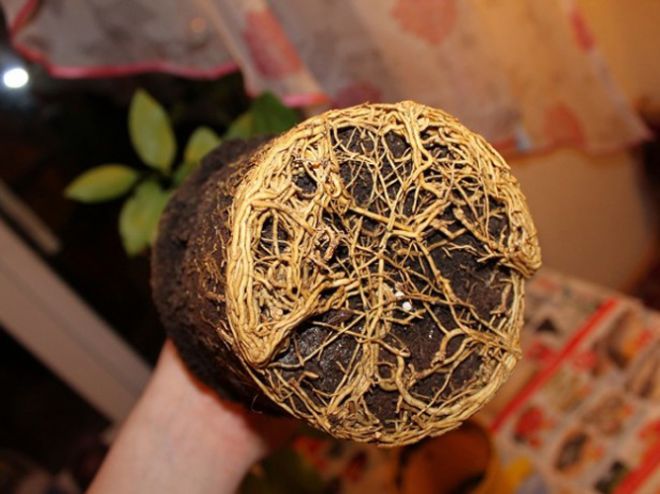

At the ends of the orange roots there are cases with mushroom colonies to absorb nutrients and moisture
On the branches there are thorns and thorns up to 10 cm long. Leaves of an orange tree live for 2 years, therefore, on one plant at the same time there can be last year's leaves, which serve to accumulate nutrients, and young ones participating in photosynthesis. Mostly old leaves fall in February - March. The dark green citrus leaf is leathery, dense, oval in shape with a sharp tip, has a size of 10 × 15 cm and a jagged or solid wavy edge. The glands of the orange leaf plate contain aromatic oils. The petioles have small winged appendages.
The harvest of oranges is largely dependent on the foliage of the plant. If for some reason the orange tree has lost its foliage, it will not bear fruit next year.
M. A. KAPTSINEL
The fruit of the orange is called hesperidium (a type of berry-like fruit) or orange. Fruits ripen from 7 to 12 months, depending on the variety. They are small and large, with a strong aroma or subtle, barely noticeable. Ripe fruits weigh from 100 to 250 g, and sometimes reach 600 g. Oranges are round or broadly oval in shape, similar in structure to berries. They are multi-seeded and seedless, have a sweet and sour taste, sometimes with a specific bitterness.
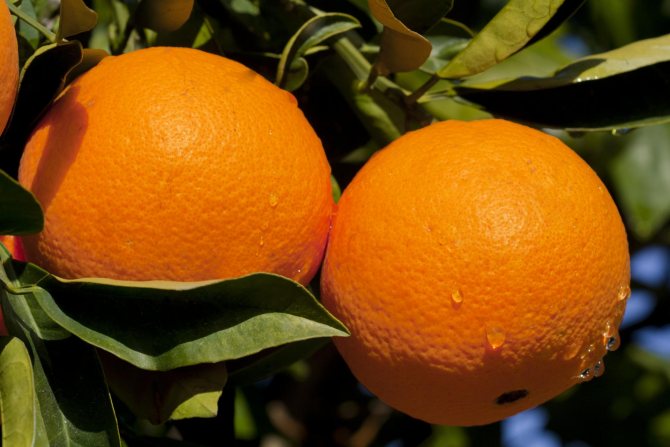

Orange is a fruit and a berry at the same time
The fruits contain:
- essential oil - up to 2%;
- sugar - 9%;
- vitamins - 68%.
The fruit pulp is multi-celled, covered with a film and consists of 9-13 slices, separated by a septum. Fragrant juice makes up about 40% of the total fruit volume. The inner part is represented by large juicy cells in the form of juice sacs, easily separated from each other.
The porous surface of the orange - the peel - accounts for 20 to 40% of the total fruit mass and has a thickness of about 5 mm. It is bright orange in color, sometimes with a reddish or yellowish tint, depending on the variety. The surface of the peel - the zest - has a pungent, ethereal aroma. The white, spongy layer inside the peel is called the albedo and is easily detached from the peel. Each slice contains 1–2 seeds, located one above the other.
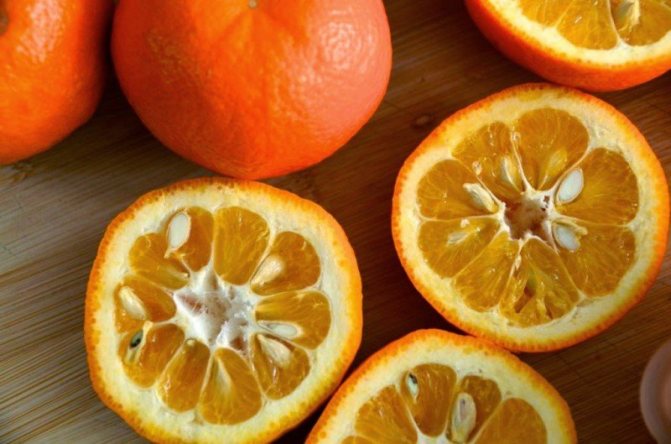

Inside the orange consists of three layers: peel, albedo and pulp with seeds
Fleur d'orange - elegant orange blossom
For the first time, young plants bloom and enter fruiting in the 3rd year of life. A snow-white basket with a large golden pistil in the middle, gathered in clusters of inflorescences at the ends of the shoots, exuding a delicate aroma with hints of jasmine - this is an orange blossom.
Usually flowers of a tropical hybrid are collected in bunches of 6–8 pieces, rarely - single ones. Orange blooms at a temperature of 16-18 degrees: in the south of Russia this is the beginning - mid-May, some varieties bloom in early June. In Spain and Turkey, the orange tree blooms in mid-March, and in Cyprus in March or April.
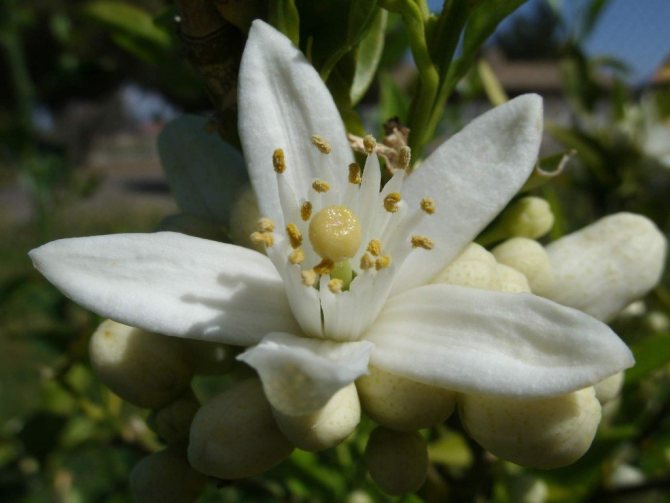

Orange flower exudes a delicate aroma
With a sharp fluctuation in the temperature background in any direction, sensitive flowers crumble. The blossoming flower is bisexual. It does not live long (no more than 5 days) and exudes a delicate, pleasant aroma. The inflorescence grows up to 5 cm in diameter when fully blooming. On it there are white-milky, sometimes with a pinkish tinge, fleshy petals (5 pieces) of an oval shape, tapering towards the end.
Surrounded by many yellow, strongly pubescent stamens, there is a single long pistil in the center. The flower does not fully open and the pistil remains surrounded by perianths - underdeveloped petals. There are varieties without pistils, they do not require pollination and produce fruits without seeds.
In French, "orange flower" sounds like "orange d'Orange".
The attractive orange blossom essential oil has a wide range of cosmetic properties and has healing properties for skin and hair. It is also called "neroli" in honor of the Italian princess Neroli, who first began to use orange blossom essential oil for cosmetic purposes.
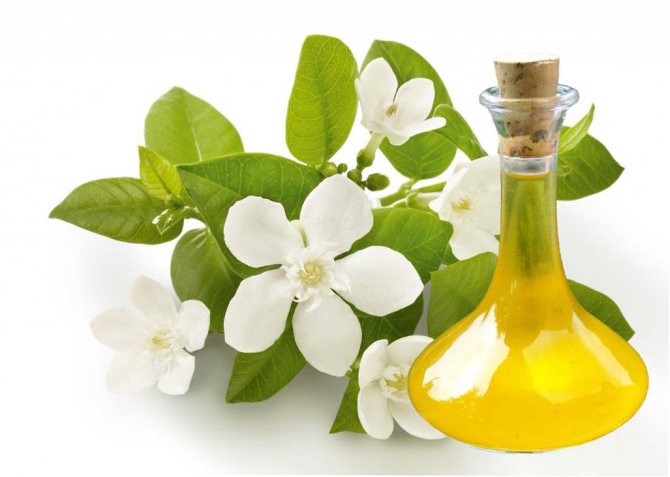

Neroli - orange blossom oil, which is used in cosmetology
Snow-white orange flowers were used in the Middle Ages in Europe as a traditional decoration for the bride's wreath.
The history of the appearance of the "Chinese apple"
For the first time, a citrus plant with a dense orange peel and sweet-sour pulp was mentioned in the ancient chronicles of East Asia around 4000 BC. e. The homeland of oranges is considered to be China, where 200 years BC. e. started growing orange trees in greenhouses. The first "oranges" that the Chinese tried were the bitter fruits of the wild-growing orange tree and were not eaten. Fragrant flowers of orange became the basis of the essence, called "bergamot", and the zest of the fruit began to be used as a tonic. This variety of wild citrus fruits later "shared" its genetic characteristics with the traditional southern culture, the fruits of which we know.
The modern orange is the result of Chinese selection, in which the pomelo and mandarin were crossed, and is not found in the wild. The first edible oranges were grown in the gardens of Chinese aristocrats. Perhaps that is why the citrus hybrid is named with the Dutch word "appelsien", which means "Chinese apple". Later, the culture was brought to the Mediterranean countries, Egypt and North Africa.
The Europeans who first tasted this amazing tropical fruit were the soldiers of Alexander the Great. In Europe, the first orange trees introduced by Portuguese seafarers were planted in the middle of the 16th century. Citrus fruits came to the Russian Empire in the 17th century and became an exquisite delicacy of noble people. At the beginning of the 18th century, oranges were grown in Georgia (Batumi region), and in the 19th century they began to be cultivated in Sochi.
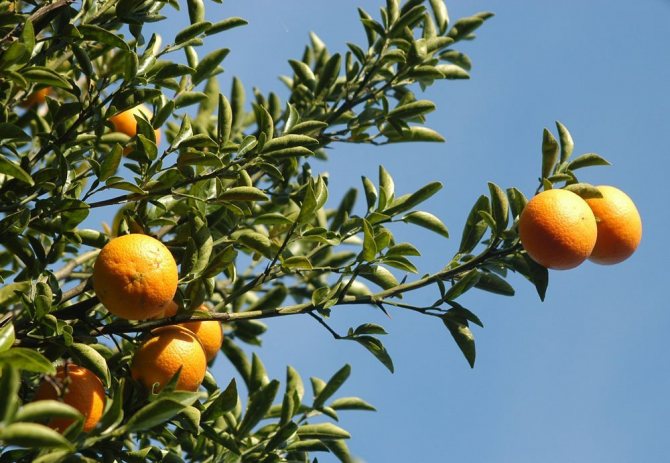

Oranges grow in different parts of the world
In ancient times, orange juice was considered an antidote to almost any poison and served as a detergent, coping with grease and dirt.
Potential harm
Contraindications to the use of this variety are standard for citrus fruits:
- pregnancy;
- breast-feeding;
- gastritis, hyperacidity;
- bowel disorder.
It is forbidden to use red orange for individual intolerance to citrus.
Conclusion
The question of which exotic is tastier or healthier (red or orange) is irrelevant. Each is good in its own way.
If you are lucky enough to taste red citrus at home or buy, you can personally evaluate the taste and determine the favorite.
It is interesting to experiment with the fruit in terms of cosmetology or cooking.
Pamper yourself with oil during water procedures, to raise the mood in the autumn slush or winter cold.
I continue to introduce you to unusual and amazing fruits, I recently talked about pineapple, its properties and selection rules. Today I want to talk about another unique fruit, this is the red orange.
It is difficult to distinguish red from an ordinary orange in appearance, but after peeling the peel, the difference becomes noticeable. But they differ in taste and are quite noticeable. Red varieties are more juicy, less acidic, do not cause such an allergic reaction in the body as other citrus fruits.
Having bought and tasted this unusual orange once, you will not remain indifferent to its taste. That's just on our shelves, it is rare.
This type of oranges is most widespread in Europe and the USA. The first natural variety of red oranges was discovered in Italy in Sicily. From three initial varieties, to date, it has been possible to breed about 10. The region of their cultivation has increased significantly, now they can be found in Spain, Morocco, USA, Tunisia and Malta.
Red, sometimes you can find the name bloody, this is not the result of crossing a pomegranate or grapefruit with an orange. It is a special variety that results from a natural mutation of the normal orange. Mandarin and pomelo have nothing to do with it either, these are all erroneous and incorrect assumptions.
In composition, a red or bloody orange is similar to orange, the same set of vitamins of groups A, C, P and B. The pulp contains fiber, chemical elements, phytoncides, a large amount of iron and calcium.
But there is one significant difference, the composition of red orange contains a bioflavonoid - anthocyanin. This substance is not characteristic of citrus fruits, it is found only in red oranges and nowhere else. The red color is the result of its influence, the reasons for the appearance of such changes are not clear.
According to one theory, anthocyanins were formed in red oranges, under the influence of certain natural factors, like the adaptation of a plant to stressful conditions. Anthocyanins have an effect on the body, similar to vitamin P, normalize blood pressure and strengthen blood vessels.
They are especially beneficial for brain cells and can improve memory. In terms of their effects, they are many times superior to vitamin C, and the benefits for the organs of vision of these substances no longer require proof.
Conducted research and study of the features of the effect of anthocyanins, have revealed their neutralizing ability in relation to free radicals, as well as a powerful antioxidant effect. The redder and richer the color of oranges, the higher its resistance to adverse conditions and its protective functions.
Studies of the properties of anthocyanins are still ongoing, but evaluating the data obtained indicate their unique and beneficial effect. Red orange is especially active, it is able to reduce the risk of developing cardiovascular diseases, all thanks to bioflavonoid substances.
Among the beneficial properties of red oranges, you can also include good activity in the fight against infections and inflammation. Therefore, it is recommended to use fruits to combat and prevent colds, flu, sore throat, inflammation in the oral cavity and nasopharynx.
When memory is weakened at an older age, red oranges are simply irreplaceable. Anthocyanins reduce cholesterol in the body.
A beneficial effect will only be if there are fresh red oranges. Many people suffering from gastrointestinal diseases, stomach ulcers or problems with the pancreas are categorically contraindicated in the use of oranges.
And red oranges are from Italy, they are eaten without negative consequences. But everything is fine in moderation, one orange a day is acceptable, and if you eat a kilogram at a time, then a healthy person will feel bad.
Red or bloody oranges cannot be replaced with orange oranges or tangerines, as many well-wishers advise, there will be no positive effect.
Juices on the packaging that say - from red oranges, are questionable in their usefulness, given the high proportion of the likelihood of their production from ordinary orange, with the addition of dyes.Technologies and methods of preparation, as well as the presence of additives and preservatives, impair quality and usefulness.
The best varieties of red Italian oranges are Tarocco, Doblefina or Double Fin, Moro, Comune Sanguinello and Moscato. Having bought such a product, you can be sure of its benefits, aromatic and unique unique taste.
I hope the article was useful to you, I advise you to pay attention to another interesting article on our website.
HOW TO CHOOSE THE MOST TASTY AND HEALTHY PINEAPPLE.
Friends for today, everyone, subscribe to our new interesting articles and recipes, come visit, read us and stay with us.
On the shores of the island of Sicily, under the hot sun, for the second century, an orange with red pulp has been growing, called the red, or Sicilian, orange. Its popularity knows no boundaries, so it is grown in Spain, Morocco, the United States, and the homeland of citrus fruits - in China. A red, Sicilian orange, also called a blood orange or a blood orange, is one of the varieties of sweet orange that has been cultivated in Europe since the 15th century.
A red orange is a type of orange that has a rich red flesh. A red (Sicilian) orange is slightly smaller than a regular orange. Its rind is crimson.
Red orange has a unique flavor range - it tastes like strawberries, grapes and raspberries at the same time. And the zest of red orange is prized for its strong aromatic properties. It is on the zest of red orange that the "Limoncello" liqueur is infused, and for aroma it is added to hot meat or fish dishes. In cooking, the pulp, rind and flowers of red orange are used.
Red oranges are grown in Spain, Morocco, China, USA. Red oranges are used for food fresh, juices are prepared from them, the zest is used as a seasoning for fish or meat dishes, liqueurs are insisted on it. Flowers are used to decorate dishes and as an original seasoning. If you put a white flower to the dish at the end of cooking, the dish will acquire a delicate spicy aroma and ... an unusual decoration
The benefits of red oranges for humans:
- normalize the activity of the cardiovascular system;
- have a beneficial effect on blood vessels, brain activity;
- normalize blood pressure;
- increase the body's defenses;
- stimulate the production of hemoglobin;
- free tissues and organs from toxins;
- improve digestion;
- increase efficiency.
Red orange can be used as an adjunct treatment for tuberculosis, asthma, bronchitis, rheumatism, pneumonia, colds, constipation, flatulence. The low calorie content of the beetle is useful for obesity.
Sicilian blood orange, what is this exotic fruit? In our opinion, orange fruits are, of course, red oranges. But among the large variety of citrus fruits there is a species that stands out noticeably against the background of others - this is a bloody orange. The fruit hybrid, depending on the area of growth, temperature, takes on a special color - from a rich bloody color to a brown-orange palette. Sweet fruit with red pulp first appeared in Italian Sicily, is still cultivated here, has been sick for two hundred years.
Varieties
Let's take a closer look at what common varieties of bloody citrus exist at the moment.
The three most common types of red oranges are Tarocco, Moro (both native to Italy) and Sanguinello (native to Spain). According to legend, the name "Tarocco" belongs to a farmer, this is how he exclaimed when he saw this citrus for the first time. These fruits are medium in size and boast of their sweetness and rich flavor. They have a thin orange peel, slightly reddened, with red streaks. Tarocco is very popular in the world because of its sweetness.
The "Tarokko" variety is a surprisingly fragrant medium-sized fruit without seeds.It is called "half-breed", its flesh does not stand out with red pigmentation, unlike the varieties "Moro" and "Sanguinello".
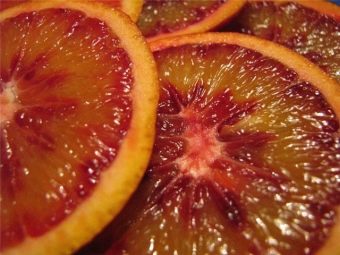

"Moro" is the brightest of the red oranges, its second name is "blood orange". The flesh is dark red in color, the color palette is rich, and can start with orange, or be ruby or even black. The peel of this type always has an intense red blush. This citrus has a pleasant, sweet scent with fruity raspberry notes. The Moro variety is believed to have been cultivated in the early 19th century in the province of Syracuse, Sicily.
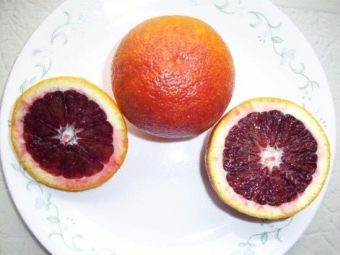

The Sanguinello variety, found in Spain 100 years later, is present in Sicily as a “full color” orange, which is close in taste to Moro. It ripens in February but can remain in the trees until April.
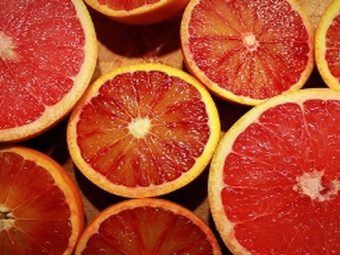

Other less common varieties include: Budd Orange, Maltese, Hanpur, Washington Sanguine, Ruby Blood, Sanguine Doble Fina, Delfino, Red Valencia and others.
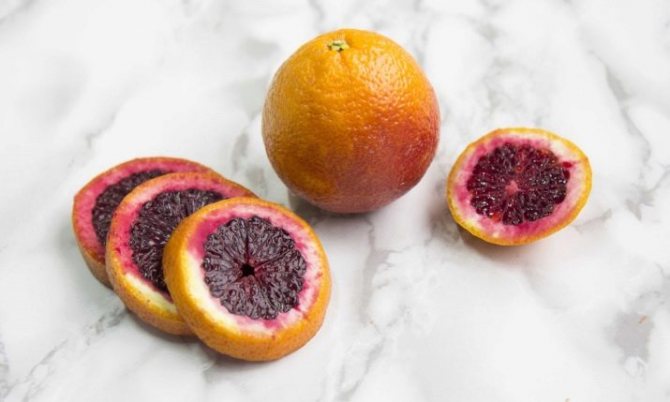

Influence on a person
It should be noted the content of such a valuable trace element as magnesium, which helps to maintain the nervous system in a calm and balanced state. Potassium improves blood flow and helps lower blood pressure. And selenium, which is part of Sicilian oranges, protects against the harmful effects of radicals.
Fruits are rich in antioxidants and terpenes. These elements inhibit the development of cancer cells in the body. They also perfectly stimulate digestion, relieve fatigue syndrome, flatulence, relieve dyspepsia. It is recommended to consume red oranges as a preventive measure to avoid anemia.
Fruit juice has anti-inflammatory properties, it can be used to rinse the mouth. The zest is also highly valued, it is not only used as a seasoning, but also prevents the development of heart disease and protects against stroke.
Varieties of orange
There are several popular varieties of red oranges. Different varieties grow in horticultural farms in the USA, South Africa, Spain, Italy, China, and in subtropical countries. Basically, they all belong to the subgroup of the Spanish "king".
These varieties include:
- sanguinelli;
- tarocco (Tarocco);
- moro, morocco (Moro);
- Washington Nevil (Washingtoh Navel);
- Valencia (Valencia Late);
- Oval (Ovale).
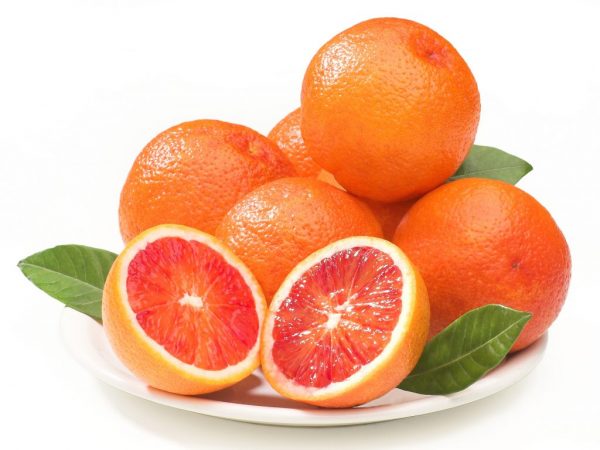

Each variety has its own characteristics
Each variety has only its inherent characteristics:
- Sanguinello has medium-sized fruits, rind color of rust, flesh is bright red, juicy, pleasant and delicate in taste. The peel is easy to peel. The shape of the fruit is oval. Seeds are rare. This is a late-ripening variety. It is appreciated as a transitional grade, used in the preparation of fresh juices. The variety belongs to double kings. Has a subspecies Muscat sanguinello (fruits are larger and more elongated, nutmeg flavor of the pulp). An unripe fruit resembles a grapefruit.
- The round, slightly elongated shape of the fruit is typical for tarocco. Its skin is orange, with light thin red stripes. The flesh tastes sweet with a slight sourness and a hint of berries. She has a garnet color. The fruit is easy to peel. Their weight is up to 200 g. This variety is characterized by a large amount of vitamin C. It is the most popular among the rest.
- The Moro variety has bright orange, oval citruses. This pigmented beetle ripens earlier than others. It is easy to determine full maturity by the red-yellow age spots. The peel is not thick, dense. The granularity is average. Few seeds. In the Moro variety, several varieties of mandarin and pamela are crossed. The pulp has a raspberry flavor. Moro contains a large amount of vitamins, minerals and beneficial acids. Fresh juices from red oranges are beneficial for both adults and children.
- Large fruits are of the Washington Neville variety. Their weight is up to 500 g. They are ellipsoidal or spherical. The peel is embossed and thick, up to 6-7 mm. The skin color is orange, in places red.The pulp has a cellular structure and a pleasant aroma. There are burgundy blotches in it. She, like the peel, is orange-red. There are few seeds.
- The Valencia variety has a rounded shape of citrus, up to 80 mm in size. The high sugar content determines the sweetness of red oranges, which contain up to 9 seeds. The skin is thin, orange, with red veins. Valencia is especially common in horticultural businesses in California and Spain. The bright pulp produces an attractive and healthy juice that is popular.
- Ovale tastes like Valencia. The shape of the fruit is oval, the thickness is medium. This variety was developed in Italy. The Oval is characterized by a tight fit of the pulp lobules to each other. The rind is dense and rough, with tubercles, red-orange. There are no seeds in almost all citrus fruits. It is easy to grow such a variety by making a stock on an ordinary tree. Citrus Morocco is similar in quality to this variety. It is not difficult to choose the right one from a set of varieties.
general description
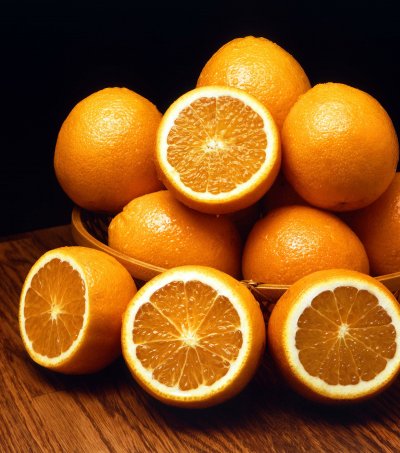

Orange is a tree that belongs to the genus citrus of the rue family.
An orange tree reaches a height of 3-12 meters or more, it lives and bears fruit for decades.
The orange blossom is white and fragrant. Flowers are arranged in groups, usually six in one inflorescence, in some varieties they protected by axillary shields.
The progenitors of this plant (pomelo and tangerine) once grew exclusively in eastern Burma; and southwestern China. These places are the birthplace of the orange.
The orange fruit is a spherical or elongated fruit that consists of several lobes with seeds inside. The flesh is covered with a thick orange or orange-red crust (yellow or green in some varieties).
INTERESTING! From a botanical point of view, the fruit of an orange tree also fits both the definition "the fruit", and so "Multi-nested berry".
The pulp of the fruit has a peculiar citrus smell and sweet and sour taste, it contains sugar, up to 2% citric acid, many useful microelements and vitamins (A, C, B vitamins). The diameter of ripe fruits is different for different varieties and ranges from 5 to 12 cm.
The peel of the fruit contains orange oil, which has been used for centuries as an aromatic additive in perfumery and as a natural flavoring agent for confectionery products.
The crown of all tree varieties is compact and round. The branches often have thin, straight thorns. Orange leaves are dense, thick, leathery, dark green, they have an elongated, oval shape. In length, the leaves reach 5-7 cm, in width - 2-3 cm.
Like all trees growing in the tropics and subtropics, the orange takes deep roots into the soil, which allows you to grow this fruit in conditions of periodic droughts.
INTERESTING! There are cases when orange trees grew and bore fruit for up to 150 years.
Types and varieties
The orange tree was obtained by crossing a mandarin and a pomelo hundreds of years ago. Over the years of experience breeders have developed hundreds of varieties of wood.
Among them there are types of oranges that can grow not only on agricultural plantations, on and in a greenhouse or city apartment. Consider the most common orange varieties - plant photos.
Sicilian orange
In Sicily, since the 18th century, several varieties of oranges have been bred with dark red, crimson and beet-red flesh. These are Tarocco, Sanguinelloi and Moro varieties, which were recently bred. It's believed that the red color of the fruit is given by chemical elements of soils of volcanic origin.
All such varieties of oranges are united by the name.


Washington Neville (Washingtoh Navel)
Variety Washington Neville has large, weighing up to half a kilogram, spherical or ellipsoidal fruits with embossed, rough, or smooth, peel.The peel of the fruit is usually thick (4-6 mm), it is orange, yellowish-orange, reddish-orange.
Sweet and sour honeycomb pulp has a pleasant smell. The pulp is also colored orange. Fruits usually have a “navel,” which is essentially a secondary fetus. This the variety is very fertile,
both on plantations and in a greenhouse or apartment.
The fruits do not contain seeds,
therefore, the plant is propagated exclusively by cuttings.
REFERENCE!
When, the Washington Neville variety is resistant to shade, but bears fruit only on the sunny side.
Valencia Late
The fruits of this common orange are round in shape, ranging in size from 70 to 78 mm, they contain a lot of sugar, therefore the pulp tastes more sweet than sweet and sour.
Valencia oranges have a wonderful taste. The pulp contains seeds, 1 to 9 seeds per fruit.
The variety has a thin, bright orange peel with small red patches and orange pulp. Valencia has been cultivated in Spain for centuries, but in the middle of the 19th century, breeders of California took up it, who received a modern prolific look.
Valencia is the world's leading raw material for juice production,
which, not least, is facilitated by the bright color of the pulp.
Ovale
The Ovale orange tastes like Valencia. Bred Ovale in Italy. The fruits are elongated, oval in shape, with a medium thickness rind and contain few seeds.
The peel adheres very tightly to the pulp slices. The surface of the peel is finely bumpy. The size of the fruits is average, they reach 6.5 - 7.5 cm in length. There are fruits in which the seeds are completely absent.
The tree grows slowly, it sensitive to seasonal temperature changes and droughts,
but in favorable conditions (including in a greenhouse), the tree can be very productive.
Tarocco
Tarocco - one of the varieties of the Sicilian orange.
Compared to other red-fleshed species bred in Sicily, its flesh is the lightest. The red color of the lobules is distributed unevenly, in the form of stripes and specks. In the fruits of Tarocco
very few seeds.
Often there are none at all.
It is a very sweet and aromatic fruit. Gardeners say that of all types of orange, Tarosso is the sweetest and most juicy. The skin of the fruit is thin, and red pigmentation is often visible against the orange peel background. Tarosso fruits contain more vitamin C than all other types. Tree grows well in a greenhouse and in a city apartment.
Bu (Bu)
Boo oranges are grown on the plantations of Vietnam,
in the subtropical and tropical zones of the country. The rind of the fruit is of medium thickness and moderate relief. The fruits are bright orange in color and slightly elongated.
This variety is very prolific.
The orange pulp is also orange, the taste of the fruit is sour-sweet or sweet, the fruit has a wonderful aroma.
Royal (King orange)
Vietnamese variety
King orange has a thick, embossed rind of dark green or bright green color and yellow flesh. These oranges are usually large (9-12 cm in diameter) and 7-9 lobes with several seeds inside the fruit.
The fruits are spherical, their weight reaches 350-400 grams.
The royal orange is very juicy and has a delicate sweet taste. Fruits grow in clusters on small trees with long flexible branches, one and a half to two meters high, each tree brings large harvests. Royal Orange plantations are found mainly in the south and central part of Vietnam.
IMPORTANT!
To get a guaranteed result, it is better to purchase orange seedlings in nurseries.
Care
When growing an orange tree at home read all instructions carefully,
which nurseries give out together with the seedling.
These are the requirements for the container in which the orange will be planted, soil preparation, temperature conditions for keeping, preparation and application of top dressing.
Only competent care for it will help to grow a tree and get fruit.
An orange tree grown at home is pleasing to the eye and is the pride of an amateur gardener. And, of course, it's always a pleasure to taste the fruits of your labors.

